外文翻译(陈鹏)
- 格式:doc
- 大小:2.74 MB
- 文档页数:9
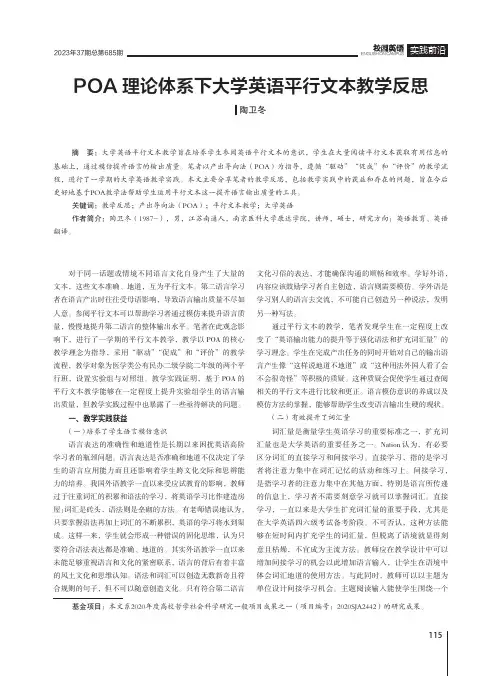
ENGLISH ON CAMPUS2023年37期总第685期POA理论体系下大学英语平行文本教学反思摘 要:大学英语平行文本教学旨在培养学生参阅英语平行文本的意识,学生在大量阅读平行文本获取有用信息的基础上,通过模仿提升语言的输出质量。
笔者以产出导向法(POA)为指导,遵循“驱动”“促成”和“评价”的教学流程,进行了一学期的大学英语教学实践。
本文主要分享笔者的教学反思,包括教学实践中的获益和存在的问题,旨在今后更好地基于POA教学法帮助学生运用平行文本这一提升语言输出质量的工具。
关键词:教学反思;产出导向法(POA);平行文本教学;大学英语作者简介:陶卫冬(1987-),男,江苏南通人,南京医科大学康达学院,讲师,硕士,研究方向:英语教育、英语翻译。
对于同一话题或情境不同语言文化自身产生了大量的文本,这些文本准确、地道,互为平行文本。
第二语言学习者在语言产出时往往受母语影响,导致语言输出质量不尽如人意。
参阅平行文本可以帮助学习者通过模仿来提升语言质量,慢慢地提升第二语言的整体输出水平。
笔者在此观念影响下,进行了一学期的平行文本教学,教学以POA的核心教学理念为指导,采用“驱动”“促成”和“评价”的教学流程,教学对象为医学类公有民办二级学院二年级的两个平行班,设置实验组与对照组。
教学实践证明,基于POA的平行文本教学能够在一定程度上提升实验组学生的语言输出质量,但教学实践过程中也暴露了一些亟待解决的问题。
一、教学实践获益(一) 培养了学生语言模仿意识语言表达的准确性和地道性是长期以来困扰英语高阶学习者的瓶颈问题。
语言表达是否准确和地道不仅决定了学生的语言应用能力而且还影响着学生跨文化交际和思辨能力的培养。
我国外语教学一直以来受应试教育的影响,教师过于注重词汇的积累和语法的学习,将英语学习比作建造房屋:词汇是砖头,语法则是垒砌的方法。
有老师错误地认为,只要掌握语法再加上词汇的不断累积,英语的学习将水到渠成。
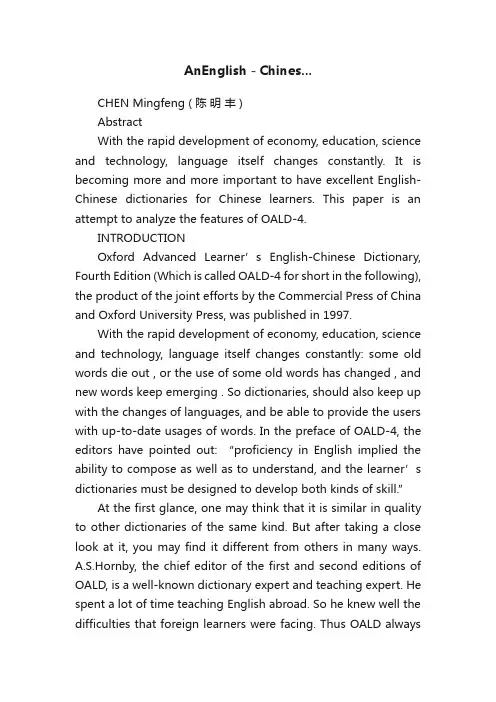
AnEnglish-Chines...CHEN Mingfeng ( 陈明丰 )AbstractWith the rapid development of economy, education, science and technology, language itself changes constantly. It is becoming more and more important to have excellent English-Chinese dictionaries for Chinese learners. This paper is an attempt to analyze the features of OALD-4.INTRODUCTIONOxford Advanced Learner’s English-Chinese Dictionary, Fourth Edition (Which is called OALD-4 for short in the following), the product of the joint efforts by the Commercial Press of China and Oxford University Press, was published in 1997.With the rapid development of economy, education, science and technology, language itself changes constantly: some old words die out , or the use of some old words has changed , and new words keep emerging . So dictionaries, should also keep up with the changes of languages, and be able to provide the users with up-to-date usages of words. In the preface of OALD-4, the editors have pointed out: “proficiency in English implied the ability to compose as well as to understand, and the learner’s dictionaries must be designed to develop both kinds of skill.”At the first glance, one may think that it is similar in quality to other dictionaries of the same kind. But after taking a close look at it, you may find it different from others in many ways.A.S.Hornby, the chief editor of the first and second editions of OALD, is a well-known dictionary expert and teaching expert. He spent a lot of time teaching English abroad. So he knew well the difficulties that foreign learners were facing. Thus OALD alwaysthinks for users, and tries to help users to learn English well. The following is the analysis of some new features of the new dictionary.FEACHURE ONE CLEAR AND CONCRETE DEFINITIONS OF ENTRIES“The definitions of entries in a dictionary is the soul of it and is directly related to its popularity.”① Samuel Johnson, the chief editor of A Dictionary of the English Language, has also pointed out: “The definition must be accurate. That’s to say, the defining words and entry words should often be able to be exchanged.” As a general rule, definitions should be comprehensible to the general readers. So does OALD-4. The definitions in it are not only accurate, but also brief. The following are definitions of “horse” in different dictionaries.Horse n. 1 solid-hoofed herbivorous quadruped (Equals caballas) with flowing mane and tail, used as beast of burden and draught, and for riding o n…----Oxford Concise DictionaryHorse n. 1 a large strong animal that people ride on and use for pulling heavy things…---Longman Dictionary of Contemporary EnglishHorse n. 1 (a) large strong four legged animal with a flowing mane and tails, used for riding on or to carry loads, pulling carts, etc.----OALD-4For readers, the meaning of “horse” is simple. But how can it be defined in English? Common sense suggests that definitions in a dictionary for speakers of English as a foreign language should not be more difficult than the words they define. Obviously, the definition in OALD-4 is the best among the three.In Oxford Concise Dictionary, there are some rarely used words like “herbivorous, quadruped”. In Longman Dictionary, the definition is brief, but i s so simple that it can’t explain the entry “horse” accurately.Besides, it also shows clearly the usage of nouns, adjectives, verbs and so on.1. Nouns: countable or uncountableAs foreign learners, especially for Chinese, it is difficult to distinguish countable or uncountable. Even some nouns are sometimes countable, sometimes uncountable. In the Chinese language, there is no such difference. In OALD-4, it is shown clearly with a label “C”(meaning countable), or “U”(meaning uncountable). For example,Study n. 1 [u](also studies [pl.]) process of gaining knowledge of a subject, esp. from books 2 [c](a) book, etc that is the result of an investigation of subject 3 [u] room esp. in sb’s home, used for reading and writing 4 [c] drawing, etc done for practice Here, OALD-4 tells us not only when the word “study” is used as countable and when uncountable, but also how to use it appropriately. And for other entries, such as experience and success, OALD-4 also gives us clear definitions. When they refer to “event or activity” and “person or thing” respectively, the two words are countable; when they refer to “knowledge or skill” and “achievement” respectively, they are uncountable.2. Adjectives: attributive use or predicative useMost adjectives can be used either before a noun or after the infinitive, such as in “a serious affair” / “be happy to go home”. However, some adjectives are restricted to attributive or predicative. In OALD-4, the appropriate label is given. For example,Asleep adj. [pred] 1 not awake, sl eeping: Don’t wake him up. She is fast / sound sleep. 2. (of limits) having no feeling; numb: I’ve been sitting on my leg and now it’s asleep.Eldest adj. [attrib.], n (of people, esp. Of three or more closely related members of a family; first born; oldest: Jim is my eldest daughter. Jill is the eldest of my three children.OALD-4 tells readers different usage of adjectives, which can help us avoid speaking or writing such sentences like “He is an asleep boy.” It is not idiomatic in English.And for other familiar words, such as “aware” or “fit”, OALD-4 also gives appropriate label. I have compared it with other dictionaries, and found that most of them have paid less attention to this point.3. Verbs: different verb patterns of sentencesIn OALD-4, there’r e thirty-two patterns (with matching codes) to account for the various ways in which verbs can be used.A code such as [Dn.pr] (as in “He gave a book to John.”) is designed to suggest to the learners ‘double-transitive verb + noun + prepositional phrase’, ie the parts of speech (or phrases or clause types) of which the pattern is composed. These indications will be sufficient for most learners. Moreover, the meanings of the letters (n=noun, a=adjective, ph=phrase, etc) can be easily learnt, so that the learners are able to recall patterns simply by looking at their codes. It is better than the first three editions of OALD, where there’s forms of codes such as VP6A, 7A, 2A, etc. So learners have to refer to the chart inside the back cover. Of course, it is also better than some other dictionaries where verbs are only divided into Vi (=intransitive verb) and Vt (=transitive verb). So the division of verb pattern is helpful for readers to use verbs appropriately. For example,Grade v. 1 [esp. passive: Tn, Tn.pr, Cn.n] ~sth/sb by/according to sth; ~sth/sb from sth to sth arrange sth/sb in order by grades or classes…2 [Tn, Cn.n](US) mark (written work); given (a student) a mark 3 [Tn]make (land, esp for roads) more nearly level by reducing the slopeHere, before ea ch meaning of this entry, there’re codes indicating verb patterns. So readers can easily learn to use the word appropriately.FEATURE TWO ABUNDANT EXAMPLES AND SYSTEMATIC COLLOCATIONSMany experts on dictionaries consider that “examples of a dictionary are important standard to judge the quality of it.”② “Examples are used to give the users a clearer impression of a word’s meaning. They should reveal the connotation and denotation of the word to help readers to understand, they also should provide phrase ex amples and collocations.”③ So as an excellent dictionary, it is useful and necessary with appropriate examples as well as accurate definitions. OALD-4, as a learner’s dictionary with more than 81,500 examples, provides exhaustive examples with a combination of sentences and phrases in the limited space. And “they (examples) help learners to understand the meanings of words, they provide models for them to imitate when writing or speaking, and they illustrate the grammatical patterns in which words are used.”④ For example,Dismiss v.1 [Tn, Tn.pr.] ~ sb. (from sth) remove sb (esp.an employee) from a position: workers who have been dismissed unfairly 2 [Tn, Tn.pr]~ sb. (from sth) send sb away; allow sb to leave: dismiss soldiers; dismiss a class 3 (a) [Tn,Tn.pr] ~ sb/sth (from sth) put (thought, feelings, etc.) out of one’s mind: he tried without success to dismiss her memory from his thought.(b) [Tn, Cn.n/a] consider sb/sth not worth thinking or talking about: she was dismissed as a dreamer: dismiss a suggestion, an objection, an idea, etc. 4 [Tn](law) reject (a case, an appeal, etc.)5 [Tn](in cricket) end the innings of (the other team or one of its batsmen)Besides plentiful verb-object word groups, OALD-4 gives adverb-verb or adverb-adjective collocations. For examples, in the entry “highly”, there are collocations like “a highly amusing film / be highly probable, contagious, inflammable/ highly priced / think highly of sb / speak highly of sb, etc.”These abundant and systematical collocations, which give readers good examples to learn and imitate, show real situations of using language, and they reflect the principle that “language is the tool of communication”.In OALD-4, to help learners to use words appropriately, a number of labels are used to denote the stylistic values of words or the technical fields in which they are used. For example, “infml” denotes “informal” words and senses, which indicates an unofficial occasion or setting. “Offensive” denotes words used to refer to people, usually with the deliberate intension of offending them, especially on account of their race or region, such as “dago, niger, etc”.FEATURE THREE ACCURATE BUT CONCISE CHINESE TRANSLATIONLadislav Zgusta, a famous expert on dictionaries, has said, “the chief duty for bilingual dictionary editors is to find the corresponding words for the source language in the target language.”⑤ So for an English-Chinese dictionary, the definition of the target language (Chinese) and that of the source language (English) are important and they both should be consideredcarefully.Some entries, which are familiar to Chinese learners, but strange to other foreign learners, are needless to explain with many words in Chinese. For examples,Abacus n. (pl –cuses) frame with beads that slide along parallel rods, used for teaching numbers to en, and (in some countries) for counting 算盘Except 1prep. ~(for sb / sth); ~(that…) not including (sb /sth); but not 除了(某人[某事物])之外表示所说的不包括在内: The restaurant is open every day except Monday.For “abacus”, the editors haven’t translated all English definition into Chinese; instead a simple corresponding word “算盘” is used. For Chinese learners, as soon as we read the Chinese definition, we can know the accurate meaning of this word.For “except”, the definition is replenished with “表示所说的不包括在内”. It helps learners tell the difference between “besides” and “except”, and finally use it properly.FEATURE FOUR RENEWAL OF LANGUAGE INFORMATIONAs OALD-4, which is a bilingual dictionary, is composed according to Oxford Dictionary of English, 4th edition, which is a monolingual dictionary, published more than ten years ago. So it is inevitable to lag behind the times. Moreover, with the rapid development of science and technology, especially computer technology, lots of new words are emerging. So OALD-4 is not restrained to the old editions, but is revised suitably to renew language information promptly by absorbing new words and abridging out-of-date ones. For example,Pious: adj1.having or showing a deep devotion to religion2. (old use )dutiful to parents---- OALD-3Pious: adj1.having or showing a deep devotion to religion2. (derog)hypocritically virtuous----OALD-4Through the comparison of the definitions in OALD-3 and OALD-4, we can know that in the Modern English, the word “pious” has the meaning of “hypocritically virtuous” instead of “dutiful to parents”.I have compared the entries in OALD-3 and OALD-4. To my surprise, the definitions and examples have changed thoroughly. At the letter of “J” (only in 14 pages), twent y new entries are included, fifteen are omitted, and more than forty are given new definitions or examples. For example:Jesuit n: member of the society of Jesus, a RC order founded in 1534 by Inguatins Logoia, Spanish priest, taking lous of obedience, poverty and chastity; (as used by opponents of the society) person who thinks that it may be right to dissemble or prevaricate if this helps to obtain good results…----OALD-3Jesuit n: 1.member of the society of Jesus, a Roman Catholic religious order 2. (derog)person who deceives others, or fails to tell the (whole)truth, to achieve his ends.----OALD-4It is obvious that the definition in OALD-4 is simpler and easier to understand than that in OALD-3. Besides, it adds a second definition. Because in modern English, the word “Jesuit” can be used to refer to “a person who deceives others to achieve his ends”. Due to the limitation of space, I would not compare other entries as examples. It is easy for us to find them if we take a close look at OALD-4.FEATURE FIVE ADEQUATE USAGE NOTES AND ILLUSTRATIONSInformation on the grammatical practical patterns in which a word can or must be found is very important to language learners. In OALD-4, for further information of a contrastive or non-lexical type, there are ab out 200 “Notes on Usage”, which follow the certain entries to deal with difficulties on grammar or usage. As a learner’s dictionary, it is used to teach learners to use this language accurately as well as to learn the words. In order to present the advanta ge of “Note on Usage”, we’d better compare the different treatments on the comparison of “almost” and “nearly”.Almost, USAGE NOTEBoth “almost” and “nearly” can be used before negative verbs: “I almost/nearly didn’t get up in time”.Almost (not nearly) can be used before any and negative words like “no, nobody, never, and nothing”. However, it is more usual to use hardly or scarcely with any, anybody, ever, etc. than almost with no, nobody, never, etc…----Longman DictionaryAlmost adv.1.(with v.v., adv. V., adj. j., n. n., replaceable by nearly): He slipped and ~ fell…2.(with no, none, nothing, never; not replaceable by nearly; often replaced by hardly or scarcely with any): Almost no one (=hardly anyone) believed her…----OALD-3Almost adv.1.(used before adv. s., n. s., adj. s., v. s., dets and prons) nearly; not quite: He slipped and almost fell.2.(used before no, nobody, none, nothing, never)virtually; practically: Almost no one (i.e. Hardly anyone) believed him.Note on Usage: Almost, nearly, scarcely, and hardly are adverbs and can be used with verbs, adverbs, adjectives and nouns.1.Almost and nearly are usually used in positive sentences: She fell and almost/nearly broke her neck. 2.Almost can be used with negative words. In these cases it can be replaced with hardly or scarcely: He ate almost nothing (=He ate hardly anything).3.Hardly is generally preferred to almost + a negative verb: She sang so quietly that I could hardly hear her (not I almost couldn’t hear).4.In sentences indicating on e thing happening immediately after another, hardly and scarcely can be placed at the beginning of the sentence and then subject and verb are inverted: Hardly/Scarcely had we arrived, when it began to rain.----OALD-4From the comparison, we see that OALD-4 not only gives a clear explanation between the difference of them, but also offers adequate examples. Other dictionaries, however, don’t do as well as OALD-4. For Longman Dictionary, though the comparison is clear, it lacks examples. For OALD-3, the comparison is included in the definitions, so it is possible for readers to ignore their difference and even get confused about them.For illustrations, OALD-4 has paid more attention to the practicality of them. Compared with OALD-3, it has added some illustrations to the appendix. On the other hand, it has omitted others, such as the picture of “abacus”. Thus it can be seen that OALD-4 is more suitable to the need of users and more “friendly to users”.Certainly, besides that is mentioned above, OALD-4 has remained some excellent features of the first three editions: 1.A good “how to use the dictionary” section. 2.a set different indication of British and American pronunciation; 3.a set ofappendixes on number; punctuation and writing; family relationships; common first names; military ranks; chemical elements; etc.However, OALD-4 is not without problems. Samuel Johnson, the editor-in-chief of A Dictionary of English Language, has said, “Dictionaries are like watches, the worst is better than none, and the bes t cannot be expected to go quite true.” For some entries, it has failed to provide supplementary information of collocation, which is absolutely necessary in our reading and writing. We can’t even find some common phrases that are often used today. The lack of them will sometimes make it inconvenient for users who are in need of them. For example:Edict n.: order or proclamation issued by an authority: by edict of the king; obey the edict of parliament.Here, it will be better to give such collocations like “sign an edict/under an edict/issue an edict, etc.”Another weak point is that in OALD-4 some definitions of entries are too tedious and annoying. For example:Milk n.: 1.a white liquid produced by cows or goats that is drunk by people.----Longman DictionaryMilk n.[u] 1.white liquid produced by female mammals as food for their young, esp. that of cows, goats, etc. drunk by human beings and made into butter and cheese.----OALD-4Though the definition in OALD-4 is accurate, it is too tedious to understand. And the Longman’s definition is concise and easy to understand.ConclusionThrough the analysis of some new features of OALD-4, wemay have a general idea about what kind of dictionary it is and what are inside it. And we may notice its differences from other learner’s dictionaries. It reflects the kernel of dictionary-composing theory---“the editing for using language in real certain situation.” It has followed the excellent principle, set up by A.S.Hornby-that it helps foreign English learners to understand and utilize English well. So OALD-4, with all its outstanding features, has stood out in the ground of the learner’s dictionaries as a very practical and helpful dictionary to those who long to learn modern everyday English. As long as we make full use of it, we are sure to learn a lot from it and to improve our English quickly in both understanding and expression.NOTES①周荐,“词典条目释义、出处索源和例句引用中借鉴与抄袭的分野问题”,见【中国辞书论集】,P29②[荷兰]阿尔卡西姆,【词典编写和评价的标准】,P162③吴莹,“双语词典的编写”,见【上海市辞书学会论文集】,知识出版社,1987,P254④“本词典用法---词条使用详细说明”,见“OALD-4”附录,1997,P1903⑤拉兹古斯塔主编, 【词典学概论】[M], 北京: 商务印书馆,1983, P428⑥陈楚祥,“词典评价十题”,见【辞书研究】,1994(1),P29References[1] A.S. Hornby; A.P. Cowie (1997) Oxford Advanced Learner’s English-Chinese Dictionary (4th ed) [M] Oxford University Press; Commercial Press of China[2] J. Pearsall (1999) Concise Oxford Dictionary of English(10th ed) [M] Oxford University Press[3] P. Procter (1995) Cambridge International Dictionary of English [M] Cambridge University Press[4] D. Summers (1995) Longman Dictionary of Contemporary English (3rd ed) [M] Longman Group Ltd.[5] A. Spears Richard (1998) NTC American English Learner’s Dictionary [M] NTC Publishing Group[6]拉兹古斯塔主编,【词典学概论】[M], 北京: 商务印书馆, 1983[7]李荫华著,【英语词典初探】[M], 北京: 商务印书馆, 1985[8]张柏然主编,【双语词典研究】[C], 北京: 商务印书馆, 1993。
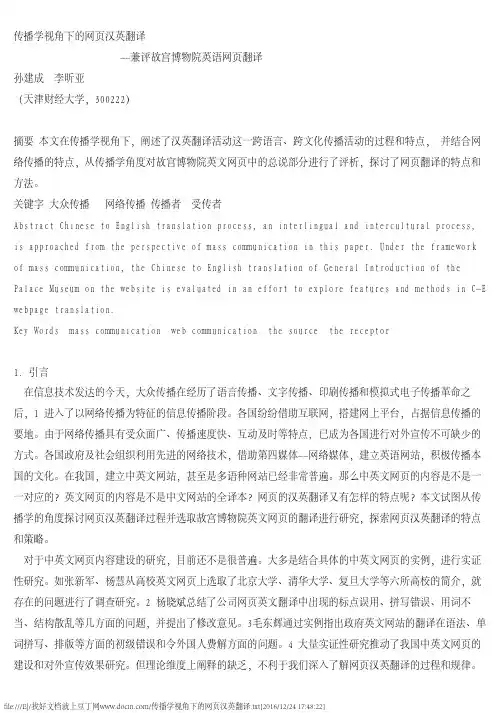
传播学视角下的网页汉英翻译--兼评故宫博物院英语网页翻译孙建成 李昕亚(天津财经大学,300222)摘要 本文在传播学视角下,阐述了汉英翻译活动这一跨语言、跨文化传播活动的过程和特点, 并结合网络传播的特点,从传播学角度对故宫博物院英文网页中的总说部分进行了评析,探讨了网页翻译的特点和方法。
关键字 大众传播 网络传播 传播者 受传者Abstract Chinese to English translation process, an interlingual and intercultural process, is approached from the perspective of mass communication in this paper. Under the framework of mass communication, the Chinese to English translation of General Introduction of the Palace Museum on the website is evaluated in an effort to explore features and methods in C-E webpage translation.Key Words mass communication web communication the source the receptor1. 引言在信息技术发达的今天,大众传播在经历了语言传播、文字传播、印刷传播和模拟式电子传播革命之后,1 进入了以网络传播为特征的信息传播阶段。
各国纷纷借助互联网,搭建网上平台,占据信息传播的要地。
由于网络传播具有受众面广、传播速度快、互动及时等特点, 已成为各国进行对外宣传不可缺少的方式。
各国政府及社会组织利用先进的网络技术,借助第四媒体--网络媒体,建立英语网站,积极传播本国的文化。
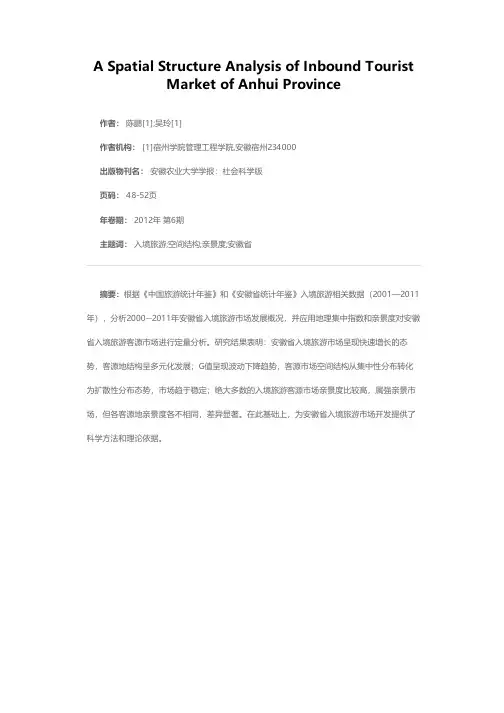
A Spatial Structure Analysis of Inbound Tourist
Market of Anhui Province
作者: 陈鹏[1];吴玲[1]
作者机构: [1]宿州学院管理工程学院,安徽宿州234000
出版物刊名: 安徽农业大学学报:社会科学版
页码: 48-52页
年卷期: 2012年 第6期
主题词: 入境旅游;空间结构;亲景度;安徽省
摘要:根据《中国旅游统计年鉴》和《安徽省统计年鉴》入境旅游相关数据(2001—2011年),分析2000--2011年安徽省入境旅游市场发展概况,并应用地理集中指数和亲景度对安徽省入境旅游客源市场进行定量分析。
研究结果表明:安徽省入境旅游市场呈现快速增长的态势,客源地结构呈多元化发展;G值呈现波动下降趋势,客源市场空间结构从集中性分布转化为扩散性分布态势,市场趋于稳定;绝大多数的入境旅游客源市场亲景度比较高,属强亲景市场,但各客源地亲景度各不相同,差异显著。
在此基础上,为安徽省入境旅游市场开发提供了科学方法和理论依据。
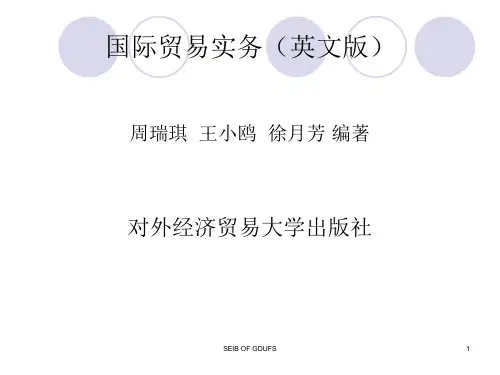

(完整)《翻译理论与实践》课程阅读书目编辑整理:尊敬的读者朋友们:这里是精品文档编辑中心,本文档内容是由我和我的同事精心编辑整理后发布的,发布之前我们对文中内容进行仔细校对,但是难免会有疏漏的地方,但是任然希望((完整)《翻译理论与实践》课程阅读书目)的内容能够给您的工作和学习带来便利。
同时也真诚的希望收到您的建议和反馈,这将是我们进步的源泉,前进的动力。
本文可编辑可修改,如果觉得对您有帮助请收藏以便随时查阅,最后祝您生活愉快业绩进步,以下为(完整)《翻译理论与实践》课程阅读书目的全部内容。
闽江学院《翻译理论与实践》课程(学生课外阅读参考书目)1、 Bell, Roger. T。
1991, 2001. Translation and Translating: Theory and Practice [M]. London:Longman Group UK Ltd.;Beijing:Foreign Language Teaching and Research Press.2、 Benjamin, W。
1993。
The Task of the Translator[A]。
In: L。
Venuti ed. 2000. The TranslationStudies Reader[C]. London & New York: Routledge。
3、 Davis, K. 2004。
Deconstruction and Translation [M]. Shanghai: ShanghaiForeignLanguage Education Press。
4、 Hatim, Basil and Mason, Ian. 1990, 2001。
Discourse and the Translator[M]。
London:Longman Group UK Ltd.; Shanghai: Shanghai Foreign Language Education Press。

价值工程我国染整行业能源损失概况A Profile on Energy Waste in the Dyeing and Finishing Industry陈臻Chen Zhen;戴达鹏Dai Dapeng;朱晓娟Zhu Xiaojuan;陈年Chen Nian(江西环境工程职业学院工业与设计学院,赣州341000)(Jiangxi Environment Engineering Vocational College School of Industry and Design,Ganzhou341000,China)摘要:本文对比分析了我国染整行业能源消耗现状与能源结构,在此基础上,以占能耗较大比重的蒸汽的损失为重点,从供热系统、热输送系统、用热系统、热回收系统等几个方面的能源损失论述了我国染整行业能源损失的概况。
Abstract:Compared the situation of energy consumption in the Dyeing and Finishing industry in our nation to those of the United States and Canada in this article.Based on the analysis on the structure of energy in the Dyeing and Finishing industry,it described the channel and shape of the energy waste,including the system of heating supply,the system of heating transport,the system of heating use,the system of heating recycle.关键词:染整行业;能源损失;概况Key words:the Dyeing and Finishing Industry;energy waste;profile中图分类号:TK0文献标识码:A文章编号:1006-4311(2011)29-0036-020引言染整是指对纺织材料(纤维、纱线和织物)进行以化学处理为主的工艺过程,其大多数工序是化学加工过程,纺织材料经化学加工后要反复水洗并加以烘干,热能和水的消耗量都非常大。
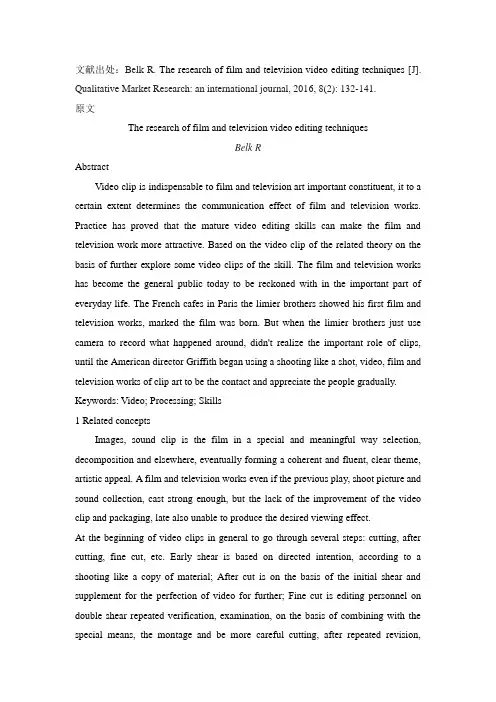
文献出处:Belk R. The research of film and television video editing techniques [J]. Qualitative Market Research: an international journal, 2016, 8(2): 132-141.原文The research of film and television video editing techniquesBelk RAbstractVideo clip is indispensable to film and television art important constituent, it to a certain extent determines the communication effect of film and television works. Practice has proved that the mature video editing skills can make the film and television work more attractive. Based on the video clip of the related theory on the basis of further explore some video clips of the skill. The film and television works has become the general public today to be reckoned with in the important part of everyday life. The French cafes in Paris the limier brothers showed his first film and television works, marked the film was born. But when the limier brothers just use camera to record what happened around, didn't realize the important role of clips, until the American director Griffith began using a shooting like a shot, video, film and television works of clip art to be the contact and appreciate the people gradually. Keywords: Video; Processing; Skills1 Related conceptsImages, sound clip is the film in a special and meaningful way selection, decomposition and elsewhere, eventually forming a coherent and fluent, clear theme, artistic appeal. A film and television works even if the previous play, shoot picture and sound collection, cast strong enough, but the lack of the improvement of the video clip and packaging, late also unable to produce the desired viewing effect.At the beginning of video clips in general to go through several steps: cutting, after cutting, fine cut, etc. Early shear is based on directed intention, according to a shooting like a copy of material; After cut is on the basis of the initial shear and supplement for the perfection of video for further; Fine cut is editing personnel on double shear repeated verification, examination, on the basis of combining with the special means, the montage and be more careful cutting, after repeated revision,editing video editing techniques to achieve director intention, film narrative and the performance of the double goals are met. Excellent editors on a large number of video clips, to try to grasp the integral style of the works, the intention of the director, programs, etc. Also need to make the film and television works stand out, independent, excellent editing procedure and editing skills. Each clip like people blink an eye, editing final purpose is to meet the needs of the audience and recognition, to work, and ultimately achieve good communication effect.2 TechniquesEditing style, namely video director will own intentions to video editors, editors to show the overall understanding and grasp, eventually form their overall creation idea of editing. Some film let the audience the feeling of being in style is not consistent, most part of the reason is the preparation and editing personnel without a unified style. For the realization of the expected effect of viewing and editing personnel in contact with the video material, must first communicate and choreographer, read a script or a shooting copy, and then choose according to the information unified editing style and make it through the whole video. Clip the ultimate goal is to reach and program, structure, content and form of the theme of the harmonious unification, editors must not throw director intention and the creation of the work itself, according to the individual subjective intend to arrange video editing style along with the gender. Editing style is roughly divided into the following categories:2.1 The traditional editing styleTraditional clip is the basic editing video clip gimmick, it is able to prevent confusion between the lens, the role is to ensure a smooth film and television video conversion, 2 it is to make the film and television works the paragraph is clear, the plot of the narrative time, place, detail and clear, avoid to cause the audience confused feeling. The traditional editing style in film editing the proportion is very big, is also must master the basic skills of editing staff.To grasp the traditional editing style need to pay attention to the following three aspects: first of all, the linkage between the lens directions cannot be disorder. Figurewalking direction, the spatial relationship between the characters to maintain consistent, not because of the transformation of the lens for the confused feeling. For example, to show the characters from the lotus pond in the park to seat walk over and characters from the picture on the left side of the entering and going out from the right, then the next shot, the characters go to the seat should be still from the left into the picture. Otherwise it will let the audience feel a sense of confusion on the vision, especially pursuit, fighting like a lens, etc. Secondly, the change in the lens to be coordinated. The so-called "dynamic", "static", is the video similar material group together in rhythm, form a kind of coordination and stable effect. "Move" is commonly used in the characters' bodies, for example, when a man slapped the other one, a lens is held up his hand before, a camera and then have a fan up continuous motion. Or in the push, pull, shake, shift, with movement in the lens, when the lens is from one scene to another scene, the camera can be directly to switch to another direction, speed close pan, forming a natural transition. "Static" are often used during transitions, two relatively stationary camera can bring harmony on the look and feel, at the same time let the audience play imagination and thinking.Finally, omit unnecessary process.In real life, the audience is familiar with the actions or behaviors, in the process of video editing often can be omitted, only a few key action, form a compact clips of coherent effects.2.2 Creative editing styleCreative editing style aims to improve the effect of the film and television works of art to watch, it including the dramatic effect clip, clip and rhythmic effect clip expressive effect. Dramatic effect clip by changing the lens of sequence and timing, change the lens clips point, finally let each shot in the plot, the best time to bring the audience find everything new and fresh, an Epiphany viewing experience. For example, in the film, props repeatedly appears in the film, it is one of the important props will film to a climax. Expressive effect clip that the whole narrative content in fluency, on the basis of editing combined with their own experience, bold selection, focus some analogy to the lens, so that the film formation reveals a certain meaning, apply colors to a drawing atmosphere effects of editing style. Rhythmic effect cliprefers to the lens time is short, the scene changes quickly, let the audience feel urgency, the effect of psychological tension, this clip effect can't disorderly use, must be combined with the overall structure and the characteristics of the plot to use film.3 The video clips rhythmsThe tempo of the film and television works determines its overall style, some works even depend entirely on the rhythm to infect the audience's emotions and feelings. Editing rhythm to organize various art elements in film and television works effectively, depicting the hero image, create a special artistic conception, and effectively push forward the plot. As a result, the overall pace of film and television works to shape the overall artistic atmosphere, improve work grade having the effect that cannot ignore, even decided to work success or failure, rhythm grasp accurate or not is one of the important factors in evaluating a film and television works.The rhythm of the film can be divided into external and internal rhythm. Internal rhythm refers to the contradiction of the plot itself, the change of character psychology and external rhythm refers to the switching speed of the camera itself, often by means of montage, lenses and other sports. In addition to film the overall rhythm, each fragment, the scene also should have certain rhythm, according to the characters' emotions, drama, image to master, in order to ensure that every scene express a complete and accurate. Editing rhythm of film and television works by images of your body movement rhythm, the rate of movement of the camera, the influence of the length of the lens, transform, the narrative plot and characters in the film and television works mood changes speed to a certain extent, determines the merits of the work.To shoot early photographers according to the director of the creation intention, the overall style of the works and their own professional choice taking lens, on the basis of this formed the basis of film rhythm. After the completion of the preliminary work, editing personnel according to the development of the plot "priorities" to form a relaxation of the editing work. Whether editing rhythm, the rhythm of the film as a whole, or the rhythm of the film passage between, to ensure that all of the appropriateness of rhythm, can't let the audience psychological uncomfortable feeling.But throughout the whole style doesn't mean the whole works always keep the same pace, but rather too appropriately according to the plot unfolds, the formation of the climax of paragraphs and low, as the pace of the film to the audience emotional fermentation. In the film "run Lola run", the three paragraphs respectively represents the three end of Laura and her boyfriend, revealed many details of life often different events that can lead to the final result. Film, Laura lost money trying to save for her boyfriend, she's crazy running lens to form a kind of fast rhythm, at the same time, the roller run of the camera and turn the lens in the clock on the wall switch, enhanced narrative sense of urgency and the sense of crisis, the audience cannot help for the lens the fate of the characters in the tension and fear.4 Apply video clip gimmickPicture like a clever can form special effects, editing, from the video images through a meaningful set, you can generate a constant association and the feeling that find everything new and fresh. The film inception, for example, in like manner, using a variety of means of montage, bring the audience into a special trip to fantasy. Like a smooth way between lens, lens the link between the way there are a lot of, for example, fade, fade in, dissolve, to make use of the means to make smooth and natural to switch between scenes, also can be used directly to the switch, jump cut, flashbacks, make the film forming a rhythm quickly, strong impact effect.译文影视视频剪辑技巧研究Belk R摘要视频剪辑是电影、电视艺术不可或缺的重要组成部分,它在一定程度上决定了影视作品的传播效果。
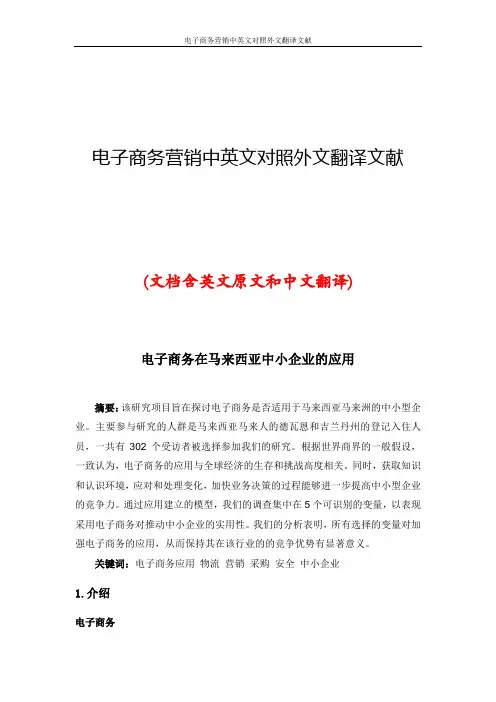
电子商务营销中英文对照外文翻译文献电子商务营销中英文对照外文翻译文献(文档含英文原文和中文翻译)电子商务在马来西亚中小企业的应用摘要:该研究项目旨在探讨电子商务是否适用于马来西亚马来洲的中小型企业。
主要参与研究的人群是马来西亚马来人的德瓦恩和吉兰丹州的登记入住人员,一共有302个受访者被选择参加我们的研究。
根据世界商界的一般假设,一致认为,电子商务的应用与全球经济的生存和挑战高度相关。
同时,获取知识和认识环境,应对和处理变化,加快业务决策的过程能够进一步提高中小型企业的竞争力。
通过应用建立的模型,我们的调查集中在5个可识别的变量,以表现采用电子商务对推动中小企业的实用性。
我们的分析表明,所有选择的变量对加强电子商务的应用,从而保持其在该行业的的竞争优势有显著意义。
关键词:电子商务应用物流营销采购安全中小企业1.介绍电子商务电子商务的出现正在根本性地改变商业进行的方式。
客户可以在其全面休闲的任何地方,任何时候购物,并且总是享受几乎没有任何成本的同等水平的服务。
显然,通过这种无纸化交易,顾客不再需要填写订购表格,或到经营场所去放置他们的订单。
什么事都可以在客户便利的条件下电子化地完成。
根据EDI报文(2000),即使中小企业因为缺乏专业知识和资金而可能有困难建立一个先进的网站,但是他们仍然需要电子商务去繁荣和持续生存。
许多个人和组织在用典型的方式去解释电子商务。
当企业开始意识到互联网作为强大媒体的角色开展业务,特别是在服务行业,因为它能够提高客户与供应商的关系,电子商务术语出现了。
电子商务是指主要的相关商业关系或交易通过互联网实现的流程,包括采购,营销,销售和客户支持。
劳顿和特拉弗形容电子商务涉及所有时间周期,速度和全球化,可以增强生产力,获取新顾客和跨机构分享知识,通过数字化实现跨边界产品和服务的交易。
电子商务是商业圈各种关系演变而成的。
它可以是企业对个人的形式(B2C),企业对企业(B2B)的形式,商业业务(BIB)的形式,和最后的个人对个人(C2C)的形式。
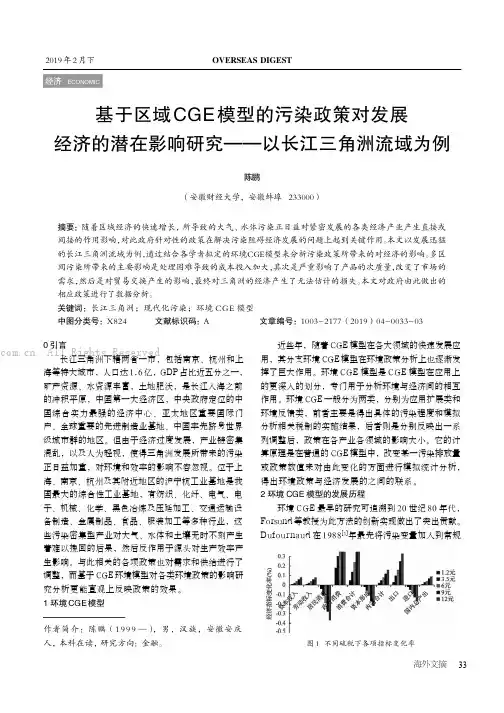
33海外文摘0 引言长江三角洲下辖两省一市,包括南京、杭州和上海等特大城市,人口达1.6亿,GDP 占比近五分之一,矿产资源、水资源丰富,土地肥沃,是长江入海之前的冲积平原,中国第一大经济区,中央政府定位的中国综合实力最强的经济中心、亚太地区重要国际门户、全球重要的先进制造业基地、中国率先跻身世界级城市群的地区。
但由于经济过度发展,产业链密集混乱,以及人为轻视,使得三角洲发展所带来的污染正日益加重,对环境和效率的影响不容忽视。
位于上海、南京、杭州及其附近地区的沪宁杭工业基地是我国最大的综合性工业基地,有纺织、化纤、电气、电子、机械、化学、黑色冶炼及压延加工、交通运输设备制造、金属制品、食品、服装加工等多种行业,这些污染密集型产业对大气、水体和土壤无时不刻产生着难以挽回的后果,然后反作用于源头对生产效率产生影响。
与此相关的各项政策也对需求和供给进行了调整,而基于CGE 环境模型对各类环境政策的影响研究分析更能直观上反映政策的效果。
1 环境CGE模型近些年,随着CGE 模型在各大领域的快速发展应用,其分支环境CGE 模型在环境政策分析上也逐渐发挥了巨大作用。
环境CGE 模型是CGE 模型在应用上的更深入的划分,专门用于分析环境与经济间的相互作用。
环境CGE 一般分为两类,分别为应用扩展类和环境反馈类,前者主要是得出具体的污染程度和模拟分析相关税制的实施结果,后者则是分别反映出一系列调整后,政策在各产业各领域的影响大小。
它的计算原理是在普通的CGE 模型中,改变某一污染排放量或政策数值来对由此变化的方面进行模拟统计分析,得出环境政策与经济发展的之间的联系。
2 环境 CGE 模型的发展历程环境CGE 最早的研究可追溯到20世纪80年代,Forsund 等教授为此方法的创新实现做出了突出贡献。
Dufournaud 在1988[1]年最先将污染变量加入到常规基于区域CGE模型的污染政策对发展经济的潜在影响研究——以长江三角洲流域为例陈鹏(安徽财经大学,安徽蚌埠 233000)摘要:随着区域经济的快速增长,所导致的大气、水体污染正日益对紧密发展的各类经济产业产生直接或间接的作用影响,对此政府针对性的政策在解决污染阻碍经济发展的问题上起到关键作用。
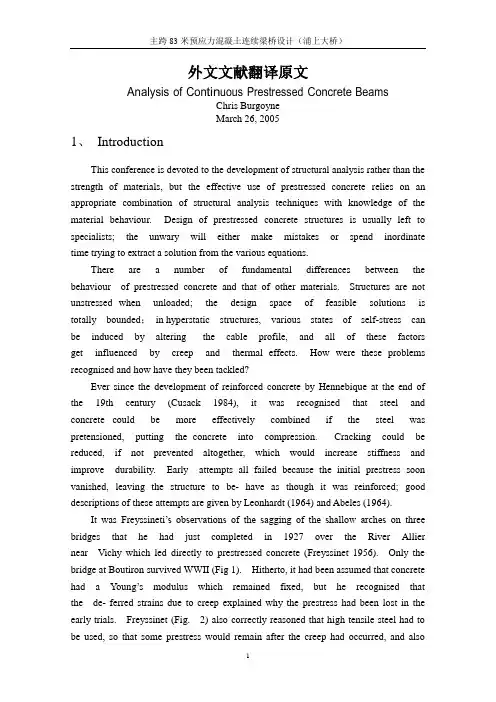
外文文献翻译原文Analysis of Con tin uous Prestressed Concrete BeamsChris BurgoyneMarch 26, 20051、IntroductionThis conference is devoted to the development of structural analysis rather than the strength of materials, but the effective use of prestressed concrete relies on an appropriate combination of structural analysis techniques with knowledge of the material behaviour. Design of prestressed concrete structures is usually left to specialists; the unwary will either make mistakes or spend inordinate time trying to extract a solution from the various equations.There are a number of fundamental differences between the behaviour of prestressed concrete and that of other materials. Structures are not unstressed when unloaded; the design space of feasible solutions is totally bounded;in hyperstatic structures, various states of self-stress can be induced by altering the cable profile, and all of these factors get influenced by creep and thermal effects. How were these problems recognised and how have they been tackled?Ever since the development of reinforced concrete by Hennebique at the end of the 19th century (Cusack 1984), it was recognised that steel and concrete could be more effectively combined if the steel was pretensioned, putting the concrete into compression. Cracking could be reduced, if not prevented altogether, which would increase stiffness and improve durability. Early attempts all failed because the initial prestress soon vanished, leaving the structure to be- have as though it was reinforced; good descriptions of these attempts are given by Leonhardt (1964) and Abeles (1964).It was Freyssineti’s observations of the sagging of the shallow arches on three bridges that he had just completed in 1927 over the River Allier near Vichy which led directly to prestressed concrete (Freyssinet 1956). Only the bridge at Boutiron survived WWII (Fig 1). Hitherto, it had been assumed that concrete had a Young’s modulus which remained fixed, but he recognised that the de- ferred strains due to creep explained why the prestress had been lost in the early trials. Freyssinet (Fig. 2) also correctly reasoned that high tensile steel had to be used, so that some prestress would remain after the creep had occurred, and alsothat high quality concrete should be used, since this minimised the total amount of creep. The history of Freyssineti’s early prestressed concrete work is written elsewhereFigure1:Boutiron Bridge,Vic h yFigure 2: Eugen FreyssinetAt about the same time work was underway on creep at the BRE laboratory in England ((Glanville 1930) and (1933)). It is debatable which man should be given credit for the discovery of creep but Freyssinet clearly gets the credit for successfully using the knowledge to prestress concrete.There are still problems associated with understanding how prestressed concrete works, partly because there is more than one way of thinking about it. These different philosophies are to some extent contradictory, and certainly confusing to the young engineer. It is also reflected, to a certain extent, in the various codes of practice.Permissible stress design philosophy sees prestressed concrete as a way of avoiding cracking by eliminating tensile stresses; the objective is for sufficient compression to remain after creep losses. Untensionedreinforcement, which attracts prestress due to creep, is anathema. This philosophy derives directly from Freyssinet’s logic and is primarily a working stress concept.Ultimate strength philosophy sees prestressing as a way of utilising high tensile steel as reinforcement. High strength steels have high elastic strain capacity, which could not be utilised when used as reinforcement; if the steel is pretensioned, much of that strain capacity is taken out before bonding the steel to the concrete. Structures designed this way are normally designed to be in compression everywhere under permanent loads, but allowed to crack under high live load. The idea derives directly from the work of Dischinger (1936) and his work on the bridge at Aue in 1939 (Schonberg and Fichter 1939), as well as that of Finsterwalder (1939). It is primarily an ultimate load concept. The idea of partial prestressing derives from these ideas.The Load-Balancing philosophy, introduced by T.Y. Lin, uses prestressing to counter the effect of the permanent loads (Lin 1963). The sag of the cables causes an upward force on the beam, which counteracts the load on the beam. Clearly, only one load can be balanced, but if this is taken as the total dead weight, then under that load the beam will perceive only the net axial prestress and will have no tendency to creep up or down.These three philosophies all have their champions, and heated debates take place between them as to which is the most fundamental.2、Section designFrom the outset it was recognised that prestressed concrete has to be checked at both the working load and the ultimate load. For steel structures, and those made from reinforced concrete, there is a fairly direct relationship between the load capacity under an allowable stress design, and that at the ultimate load under an ultimate strength design. Older codes were based on permissible stresses at the working load; new codes use moment capacities at the ultimate load. Different load factors are used in the two codes, but a structure which passes one code is likely to be acceptable under the other.For prestressed concrete, those ideas do not hold, since the structure is highly stressed, even when unloaded. A small increase of load can cause some stress limits to be breached, while a large increase in load might be needed to cross other limits. The designer has considerable freedom to vary both the working load and ultimate load capacities independently; both need to be checked.A designer normally has to check the tensile and compressive stresses, in both the top and bottom fibre of the section, for every load case. The critical sections are normally, but not always, the mid-span and the sections over piers but other sections may become critical ,when the cable profile has to be determined.The stresses at any position are made up of three components, one of which normally has a different sign from the other two; consistency of sign convention is essential.If P is the prestressing force and e its eccentricity, A and Z are the area of the cross-section and its elastic section modulus, while M is the applied moment, then where ft and fc are the permissible stresses in tension and compression.c e t f ZM Z P A P f ≤-+≤Thus, for any combination of P and M , the designer already has four in- equalities to deal with.The prestressing force differs over time, due to creep losses, and a designer isusually faced with at least three combinations of prestressing force and moment;• the applied moment at the time the prestress is first applied, before creep losses occur,• the maximum applied moment after creep losses, and• the minimum applied moment after creep losses.Figure 4: Gustave MagnelOther combinations may be needed in more complex cases. There are at least twelve inequalities that have to be satisfied at any cross-section, but since an I-section can be defined by six variables, and two are needed to define the prestress, the problem is over-specified and it is not immediately obvious which conditions are superfluous. In the hands of inexperienced engineers, the design process can be very long-winded. However, it is possible to separate out the design of the cross-section from the design of the prestress. By considering pairs of stress limits on the same fibre, but for different load cases, the effects of the prestress can be eliminated, leaving expressions of the form:rangestress e Perm issibl Range Mom entZ These inequalities, which can be evaluated exhaustively with little difficulty, allow the minimum size of the cross-section to be determined.Once a suitable cross-section has been found, the prestress can be designed using a construction due to Magnel (Fig.4). The stress limits can all be rearranged into the form:()M fZ PA Z e ++-≤1 By plotting these on a diagram of eccentricity versus the reciprocal of the prestressing force, a series of bound lines will be formed. Provided the inequalities (2) are satisfied, these bound lines will always leave a zone showing all feasible combinations of P and e. The most economical design, using the minimum prestress, usually lies on the right hand side of the diagram, where the design is limited by the permissible tensile stresses.Plotting the eccentricity on the vertical axis allows direct comparison with the crosssection, as shown in Fig. 5. Inequalities (3) make no reference to the physical dimensions of the structure, but these practical cover limits can be shown as wellA good designer knows how changes to the design and the loadings alter the Magnel diagram. Changing both the maximum andminimum bending moments, but keeping the range the same, raises and lowers the feasible region. If the moments become more sagging the feasible region gets lower in the beam.In general, as spans increase, the dead load moments increase in proportion to the live load. A stage will be reached where the economic point (A on Fig.5) moves outside the physical limits of the beam; Guyon (1951a) denoted the limiting condition as the critical span. Shorter spans will be governed by tensile stresses in the two extreme fibres, while longer spans will be governed by the limiting eccentricity and tensile stresses in the bottom fibre. However, it does not take a large increase in moment ,at which point compressive stresses will govern in the bottom fibre under maximum moment.Only when much longer spans are required, and the feasible region moves as far down as possible, does the structure become governed by compressive stresses in both fibres.3、Continuous beamsThe design of statically determinate beams is relatively straightforward; the engineer can work on the basis of the design of individual cross-sections, as outlined above. A number of complications arise when the structure is indeterminate which means that the designer has to consider, not only a critical section,but also the behaviour of the beam as a whole. These are due to the interaction of a number of factors, such as Creep, Temperature effects and Construction Sequence effects. It is the development of these ideas whichforms the core of this paper. The problems of continuity were addressed at a conference in London (Andrew and Witt 1951). The basic principles, and nomenclature, were already in use, but to modern eyes concentration on hand analysis techniques was unusual, and one of the principle concerns seems to have been the difficulty of estimating losses of prestressing force.3.1 Secondary MomentsA prestressing cable in a beam causes the structure to deflect. Unlike the statically determinate beam, where this motion is unrestrained, the movement causes a redistribution of the support reactions which in turn induces additional moments. These are often termed Secondary Moments, but they are not always small, or Parasitic Moments, but they are not always bad.Freyssinet’s bridge across the Marne at Luzancy, started in 1941 but not completed until 1946, is often thought of as a simply supported beam, but it was actually built as a two-hinged arch (Harris 1986), with support reactions adjusted by means of flat jacks and wedges which were later grouted-in (Fig.6). The same principles were applied in the later and larger beams built over the same river.Magnel built the first indeterminate beam bridge at Sclayn, in Belgium (Fig.7) in 1946. The cables are virtually straight, but he adjusted the deck profile so that the cables were close to the soffit near mid-span. Even with straight cables the sagging secondary momentsare large; about 50% of the hogging moment at the central support caused by dead and live load.The secondary moments cannot be found until the profile is known but the cablecannot be designed until the secondary moments are known. Guyon (1951b) introduced the concept of the concordant profile, which is a profile that causes no secondary moments; es and ep thus coincide. Any line of thrust is itself a concordant profile.The designer is then faced with a slightly simpler problem; a cable profile has to be chosen which not only satisfies the eccentricity limits (3) but is also concordant. That in itself is not a trivial operation, but is helped by the fact that the bending moment diagram that results from any load applied to a beam will itself be a concordant profile for a cable of constant force. Such loads are termed notional loads to distinguish them from the real loads on the structure. Superposition can be used to progressively build up a set of notional loads whose bending moment diagram gives the desired concordant profile.3.2 Temperature effectsTemperature variations apply to all structures but the effect on prestressed concrete beams can be more pronounced than in other structures. The temperature profile through the depth of a beam (Emerson 1973) can be split into three components for the purposes of calculation (Hambly 1991). The first causes a longitudinal expansion, which is normally released by the articulation of the structure; the second causes curvature which leads to deflection in all beams and reactant moments in continuous beams, while the third causes a set of self-equilibrating set of stresses across the cross-section.The reactant moments can be calculated and allowed-for, but it is the self- equilibrating stresses that cause the main problems for prestressed concrete beams. These beams normally have high thermal mass which means that daily temperature variations do not penetrate to the core of the structure. The result is a very non-uniform temperature distribution across the depth which in turn leads to significant self-equilibrating stresses. If the core of the structure is warm, while the surface is cool, such as at night, then quite large tensile stresses can be developed on the top and bottom surfaces. However, they only penetrate a very short distance into the concrete and the potential crack width is very small. It can be very expensive to overcome the tensile stress by changing the section or the prestress。
新闻与传播研究NEWS RESEARCH一部信息全球化时代新闻翻译的实用指南──评贝尔萨和巴斯内特的《国际新闻翻译》□ 刘咏波一、引言随着世界经济一体化和信息全球化的不断发展,大众传播媒介都需要翻译大量国际新闻来满足大众的信息需求。
近年来,新闻翻译成为快速发展的研究领域,方兴未艾,引起了众多翻译和传媒工作者的共同关注。
2011年3月,上海外语教育出版社引进出版了由英国翻译研究的领军人物巴斯内特(Susan Bassnett)和传媒翻译学者贝尔萨博士(Esperança Bielsa)合著的《国际新闻翻译》(Translation in Global News),成为该社“国外翻译研究丛书”的新成员(第三十七本),我国新闻和外宣翻译的资深研究专家、上海外国语大学博士生导师张健教授为该书撰写了导读。
《国际新闻翻译》英文原版由英国劳特里奇出版公司于2009年在英国和美国同步出版,该书英文版虽然只有薄薄的162页,但它无论是对新闻工作者还是翻译人员都具有十分重要的学术价值,同时它更是一部信息全球化时代新闻翻译的实用指南。
该书集全球化、媒体学、社会学和翻译学等学科为一体,反映了信息化时代新闻翻译的热点问题,探讨了全球化视野下的翻译概念和策略。
该书的一大特点是,作者详细介绍了路透社、法新社和国际新闻社等世界主要新闻机构在全球化背景下对翻译的理解和运作,并结合这几大通讯社的大量新闻翻译实例,探讨了全球化给新闻翻译带来的挑战以及新闻翻译的技巧,并通过分析西方媒体中对阿拉伯世界的英语版报道,指出新闻媒体是如何受到文化和宗教因素制约的。
二、关于作者苏珊・巴斯内特(Susan Bassnett)可谓文化翻译学派的领军人物,在国际译坛有很高的威望和深远影响。
巴斯内特是英国华威大学(University ofWarwick)翻译与比较文化研究中心资深教授,早年在欧洲多国接受过教育,此教育背景使她掌握了多种语言,深入了解多种文化,这为她后来的翻译及比较文化研究打下了良好的基础。
《生死疲劳》中文化负载词的英译研究一、引言本文运用jef verschueren 提出的语用顺应论,通过语境关系顺应、语言结构顺应和顺应的动态性三个视角,研究和分析莫言《生死疲劳》中的文化负载词。
二、文化功率词每一种语言都有“文化负载词”,这类词语体现了一个民族的传统文化的精髓。
mona baker()认为,文化负载词是“源语中表达的概念在目标文化中可能并不存在。
这种概念可能是抽象或具体的,可能与一种宗教信仰、一种社会风俗或一种食物有关。
这种概念被称为文化特性(culturalspecific)”。
三、迎合论jef verschueren() 提出顺应论,他认为语言有三种特性:变异性、商讨性、和顺应性。
同时,他认为在语言的顺应过程中,有四个方面的不同顺应。
第一个方面是语境关系顺应,语境关系顺应是指语言的选择必须与语境达到顺应。
其次是语言结构顺应,语言结构顺应是指语言结构的各个层次达到顺应,在语音、句型、语体等方面都要达到顺应。
再次是顺应的动态性,以及顺应过程的意识凸显性。
它是指在使用语言的过程中要考虑到语言使用的时间、社会关系和语篇结构等因素,翻译时必须顺应具体的语境以及具体的语言结构。
其中动态顺应是verschueren 语用学观点的核心内容。
1、语境关系迎合在翻译中,译者要顺应的不仅仅是原文所描写的世界,同时还要顺应译文预期读者的世界,这样才能达到交际和语言的顺应。
基准1. 原文:??像是炸鸡一样烧了半个时辰,痛苦之状,难以言表。
(莫言,:3)译文: ?i tumbled and turned and sizzled likea fried chicken for about anhour.(howard goldblatt,:3)“半个时辰”在这个语境中并不是具体内容的时间的抒发,而只是抒发所受到折磨的时间之短。
这就是中国古代则表示时间的一种表达方式,一个时辰相等于现在的两个小时,葛浩文在译文中将“半个时辰”译者为了“about an hour”,而不是具体内容为“halfof two hours”,这样的处理方式不仅更合乎英语的表达方式,而且把时间模糊化而不是抽象化,更好的'彰显出来“备受折磨”以及“这半个时辰的时间不好过”这一层语境意义。
壳聚糖与聚(甲基丙烯酸)的聚电解质复合物的结构和性质陈世兰柳明珠金淑萍陈勇摘要:使用UV-可见光光度计、荧光探针技术、透射电子显微镜对壳聚糖聚电解质复合物(CS)的结构和性能及聚(甲基丙烯酸)的水溶液进行了透光率的测量。
利用量热法差示扫描测定固体复合物的热性能。
结果表明,CS:PMAA的的最佳摩尔配比(单体单元)是1:4,在pH = 4时。
即,当CS:PMAA进料比(摩尔单体单元)是1:4时,在CS和PMAA之间有一个最佳配比,也就是一个氨基离子基团和平均每四个羧酸(或羧基)基团之间能够形成一个离子键。
PMAA构象通过络合作用从一个紧密的线圈变成一个松散的线圈以及pH值和聚电解质复合物的盐敏感的范围相比较于CS或PMAA有了明显的不同。
在详细讨论了各种外部条件下的复合物的形成过程。
透射电子显微镜观察发现,CS–PMAA复合颗粒的大小随pH或盐浓度的增加和复杂的形态发生变化。
热分析进一步表明,在混合水溶液中存在着结构和性能的改变。
关键词:分子间的相互作用;复合行为;聚电解质复合物;壳聚糖;聚(甲基丙烯酸)引言聚电解质大分子携带了大量带电的官能团,在适当的条件下,可以成为带电。
稳定的聚电解质复合物(PECS)可以通过一个聚电解质与另一个带相反电荷的聚电解质的反应形成。
PECS的形成的驱动力是很强的库仑力的相互作用。
在过去的几十年中,PECS应用领域快速发展,从大型工业用涂料,粘合剂,和多层聚电解质胶囊到生物技术和医学领域等特殊用途。
壳聚糖(CS)是一种天然的生物聚合物和大自然中的第二个继纤维素最丰富的生物聚合物。
由于其主链的存在,它已被认为是一个碱性氨基多糖。
CS已受到大量的研究关注,由于其独特的生物相容性,生物降解,无毒,和药用性能,并广泛应用于生物医学和生物工程的。
甲基丙烯酸已报道有良好的生物相容性, 甲基丙烯酸的聚合物,聚(甲基丙烯酸)(PMAA),是一个典型的酸性电解质,其构象取决于稀溶液中的pH值。
铜促进三氟甲基化和三氟甲基芳基重氮四氟硼酸盐与三氟甲基亚磺酸钠(NaSO2CF3)的反应Ke Zhang,Xiu-Hua Xu,和 Feng-Ling Qing大学化学,化学工程与生物技术,东华大学,2999北人民路,上海201620(中国)有机氟化学重点实验室、上海有机化学研究所,中国科学院,零陵路00345号,上海200032(中国)支持信息:摘要:现已开发了可选择的芳基重氮四氟硼酸盐与Langois试剂(NaSo2CF3)的三氟甲磺酰基化和三氟甲基芳化。
以DMSO作为溶剂的Cu2O催化反应下主要生成产物三氟甲磺酰基芳。
另一方面,三氟甲基芳烃是在氧化剂叔丁基过氧化氢,CuBF4(MeCN)4,2,2′;6′,2″-吡啶(tpy)的存在下生成。
这些转变都是在温和的条件进行和具有良好的官能团耐受性。
简介:含氟基团的芳香族化合物在医药业和农药行业将是非常重要的,因为含氟基团能使芳香族化合物改善代谢稳定性;使其具有独特的物理和化学性能、更高的亲脂性和更好的生物利用度。
[1]因此,在有机合成中对含有氟芳香族化合物的制备具有持续兴趣。
最近,已经开发了主要涉及过渡金属催化/介导的氟化/氟烷基化反应的新的合成方法。
[2]我们通常从易获取的市售苯胺中获得芳基重氮盐,通过Sandmeyer反应制备官能化芳烃。
命名为Balz−Schiemann 的苯胺类到芳香族氟化物转化是一个典型的例子(方案1a)[4]。
最近,Sandmeyer反应已被证明是引入含氟基团到芳香环(方案B)的有效策略,包括引入三氟甲基(CF3)、[5、6]三氟甲基硫(SCF3)、二氟甲基(CF3H)、[7]二氟甲基硫代(SCF2H)和全氟烷基(R F)[9]。
通过这些研究受到启发,我们知道了芳三氟甲磺酰基(ArSO2CF3)可以由芳基重氮盐制备。
芳三氟甲磺酰基是重要的结构片段,经常在生物活性化合物[10],手性催化剂[11],和[9]利用三氟甲磺酰基组的独特性质(SO2CF3)的功能材料中发现[12]。
第24卷第1期2024年1月交 通 工 程Vol.24No.1Jan.2024DOI:10.13986/ki.jote.2024.01.006基于道路网络的东莞市交通事故时空特征分析杨 素1,何 辉2,陈 鹏1,方 星3(1.中国人民公安大学信息网络安全学院,北京 102600;2.乌鲁木齐市公安局,乌鲁木齐 830022;3.东莞市公安局,东莞 523000)摘 要:以道路网络为空间尺度,对东莞市2019⁃01⁃01 2020⁃12⁃31交通事故开展时空分析,选取洛伦兹曲线及基尼系数探讨事故聚集程度,引入事故严重程度指数Si,采用自然间断点分级法对比分析事故时空分布特征.结果表明:①交通事故在道路网络中呈现出明显聚集性,工作日多个时段呈现为热点路段,休息日中事故热点减少;②加权Si 前后,事故热点分布存在差异,具体表现为工作日事故热点路段明显减少,休息日事故热点路段增多,且出现了等事故数少但事故严重程度高的路段,反映出考虑事故严重程度会得到不同时空分布特征.本文基于道路网络分析东莞市交通事故时空分布特征,为交通事故预防提供了针对性的理论参考,对改善东莞市交通状况具有一定价值.关键词:交通事故;自然间断点分级法;时空分析;事故热点;东莞市中图分类号:U 491.31文献标志码:A文章编号:2096⁃3432(2024)01⁃032⁃06收稿日期:2023⁃12⁃03.基金项目:中国人民公安大学基本科研业务费项目(2023JKF01ZK12),北京市自然科学基金面上项目(9192022).作者简介:杨素(1999 ),女,硕士,研究方向为犯罪时空研究.E⁃mail:2021211482@.通讯作者:陈鹏(1981 ),男,博士,教授,研究方向为犯罪地理和公安大数据分析研究.E⁃mail:chenpeng@.Spatial⁃Temporal Characteristics of Traffic Accidents in Dongguan Based on Road NetworkYANG Su 1,HE Hui 2,CHEN Peng 1,FANG Xing 3(1.School for Informatics Cyber Security,People’s Public Security University of China,Beijing 102600,China;2.Urumqi Public Security Bureau,Urumqi 830022,China;3.Dongguan Public Security Bureau,Dongguan 523000,China)Abstract :This paper adopts natural breaks classification method to carry out spatio⁃temporal analysis of accidents,selects Lorentz curve and Gini coefficient to mine accident aggregation characteristics of administrative division and road network,and introduces accident severity index Si,exploring the distribution of traffic accident hot spots in Dongguan from January 1st,2019to December 31st,2020.The results show that:(1)Traffic accidents show significant clustering in the road network,and other hot sections appearing at multiple times during weekdays.At the weekend,accident hotspots decrease;(2)Before and after weighted Si,there are differences in the distribution of accident hot spots,which are manifested by significant changes in the number of accident hot spots on weekdays and weekends,as well as different hot road sections,reflecting the different spatiotemporal distribution characteristics obtained by considering the severity of accidents.This article analyzes the spatiotemporal distributioncharacteristics of traffic accidents in Dongguan based on road network analysis,providing targeted theoretical reference for traffic accident prevention and has certain value in improving the traffic situationin Dongguan. 第1期杨 素,等:基于道路网络的东莞市交通事故时空特征分析Key words:traffic accident;natural breaks classification method;spatio⁃temporal analysis;accident hot spots;Dongguan0 引言近年来,我国机动车保有量和机动车驾驶人数不断上升,交通行驶环境日益复杂,交通事故频发,交通状况态势不容乐观.已有研究表明,交通事故具有一定的时间模式和空间模式,其在空间和时间上的分布具有不均匀性[1⁃3].对交通事故进行时空分析,识别事故热点并挖掘事故时空分布特征,可为交通安全管理提供科学依据,从而有针对性地制定交通安全策略和措施.学者们对交通事故的早期研究主要是将数理统计方法运用于分析事故时空分布特征[4⁃8]㊁鉴别及检验事故热点[9⁃14]等.随着对交通事故空间模式探索的深入,空间统计方法被运用于交通事故时空分析工作,具体可分为空间聚类[15⁃20]㊁核密度估计[21⁃23]等方面.张光南等[15]基于广州市交通事故空间热力图提取9个事故热点区域,通过系统聚类法分析事故影响因素,归纳出商业地区㊁市中心等3类事故高发区.柳林等[11]通过核密度估计法定性分析惠州市2010年交通事故的时空变化,发现城市空间结构会对事故发生产生影响.已有研究或是在整个研究地区内探索事故热点区域,或是基于行政区划这一空间视角,对交通事故在不同行政区划内的分布情况进行简单可视化[24],对事故时空分析的空间尺度较为单一.由于交通事故依赖于道路交通系统,其空间现象受道路网络的约束[25],部分学者尝试从道路网络的视角对交通事故展开时空分析研究,Colak等[21]引入网络空间权重,采用核密度估计法识别土耳其里泽省45km主干道上的交通事故热点;朱芳琪等[17]结合GIS与改进的时空密度聚类方法,对2016 2018年湖南省高速公路交通事故进行时空可视化统计分析并识别事故多发路段.此外,当前交通事故时空分析大多基于交通事故数展开.事实上,不同类型交通事故(如死亡事故㊁伤人事故㊁财产损失事故等)对道路交通系统的影响程度以及对人们生命健康㊁财产安全的危害程度不同,在交通事故时空分析工作中事故严重程度同样值得关注.本文在已有研究基础上,以东莞市2019⁃01⁃01 2020⁃12⁃31交通事故为研究对象,采用洛伦兹曲线及基尼系数㊁自然间断分级法,同时引入事故严重程度指数,试图从道路网络这一空间尺度揭示东莞市交通事故时空热点分布特征,为交通事故预防提供参考.1 研究区域概况与数据来源1.1 研究区域概况本文的研究区域为广东省东莞市,该市为珠江三角洲中心城市之一㊁粤港澳大湾区城市之一,是广东省重要的交通枢纽.东莞市不设区,下辖28个镇㊁4个街道㊁2个管委会㊁1个生态园.该市总面积2542.67km2,常住人口数为1043.7万人,汽车保有量超300万[26].从常住人口数量来看,东莞属特大城市,但其总面积小,使得该市人口密度大,同时汽车保有量大,交通事故频发,以东莞市为研究区域开展交通事故具有典型意义.图1 东莞市行政区划1.2 数据来源及预处理本文所用数据包括脱敏后的交通事故数据和道路网络数据.交通事故数据为2019⁃01⁃01 2020⁃12⁃31东莞市交通事故记录,共11502条,每条记录包含15个属性,可分为事故基本属性㊁环境属性㊁事故评价属性3大类.事故基本属性包含事故编号㊁事故地点㊁发生时间㊁伤亡人数等,环境属性为行政区划㊁道路养护单位等,事故评价属性则为事故类型㊁事故标签等.道路网络数据来自Open Street Map(OSM)开源地图下载平台[27],经行政边界裁剪后得到矢量路网数据,共19306条路段.根据研究区域范围进行交通事故数据筛选,删除空间位置明显偏离的事故数据67条,补全包33交 通 工 程2024年含空值的事故数据20条,剩余事故数据为11435条.通过对道路网络进行路网简化㊁拓扑检查等处理,共获取12830条路段.为了防止将偏离路段过远的事故点匹配至路段上,通过将事故点投影至最近路段,得到每一事故点至最近路段的距离,统计该距离的累计频率分布,假定距离小于d 的事故点占所有数据点的80%,则设置d 为缓冲区宽度,将对应的投影点作为新的交通事故数据点,删除其余不位于缓冲区内的交通事故数据点.通过统计,确定缓冲区宽度为176m,共获得9148条交通事故点的路段匹配结果.2 研究方法2.1 研究框架本文首先对东莞市交通事故数据及道路网络数据进行预处理,将交通事故点匹配至相应路段;其次,选取洛伦兹曲线及基尼系数定性㊁定量分析事故聚集特征,在自然间断点分级法的基础上引入事故严重程度指数Si,将一周分为工作日㊁休息日,1d 分为00:00 06:00㊁06:00 12:00㊁12:00 18:00㊁18:00 24:004个时段,对比分析加权Si 前后,不同时段下道路网络的事故时空分布特性.具体研究框架如图2所示.图2 研究框架2.2 洛伦兹曲线与基尼系数作为研究国民收入在国民之间的分配不均等问题的坐标图形和分析指标,洛伦茨曲线与基尼系数已被广泛应用于经济社会发展的各个领域[28].本文采用洛伦兹曲线与基尼系数分析事故在道路网络中的聚集特征,事故洛伦茨曲线是根据事故累积百分比和道路网络累积百分比绘制的曲线,定性刻画了事故分布的不均匀程度.由洛伦兹曲线可计算得出基尼系数,基尼系数的取值位于0~1之间,且越接近1时事故聚集程度越高[29],见式(1):G =1-∑N -1i =1(M i +1-M i )(N i +1+N i )-M 1N 1(1)式中,M i 为第i 个道路网络的事故累积百分比;N i 为对应道路网络的累积百分比.2.3 引入事故严重程度指数的自然间断点分级法自然间断点分级法基于数据中固有的自然分组,对相似值进行最恰当的分级,并使各个类之间的差异最大化[30],已被广泛应用于空间数据分类[31⁃33].本文采用自然间断点分级法划分道路网络中的事故热点分布等级,同时引入事故严重程度指43 第1期杨 素,等:基于道路网络的东莞市交通事故时空特征分析数,分析事故时空分布特征.为区分事故严重程度,参考我国道路交通事故等级的相关标准,根据伤亡人数和经济损失计算事故严重程度指数,由于东莞市交通事故数据中包含每次事故的死亡人数㊁受伤人数,缺乏经济损失数据,见式(2):Si =A 1W +A 2Q +A 3Z(2)式中,S i 为第i 起事故的事故严重程度指数;W 为死亡人数;Q 为受伤人数;A 1㊁A 2为死亡人数㊁受伤人数的权重系数,设置为0.5㊁0.1;A 3为经济损失的权重系数,设置为0.05;Z 为是否为财产损失事故,若为财产损失事故,则取1,若为死亡事故或伤人事故,取0.3 结果及分析3.1 道路网络事故聚集特征根据交通事故点的道路网络匹配结果,统计每一路段包含的交通事故数,以每10起事故为统计区间将其分成13类,得到道路网络上的事故分布情况,如图3所示.可以看出,0~10起区间内的路段一共有1876条,占路段总数的87.91%,而交通事故数大于40起区间内分布的路段均为个位数,呈断崖式减少.图3 道路网络事故分布根据道路网络事故数量绘制洛伦茨曲线,得到结果如图4所示.同时,计算得到基尼系数为0.89,说明道路网络中不同路段上的交通事故数差距较大,绝大部分交通事故仅聚集在极少路段中,交通事故在道路网络中的聚集程度很高.3.2 事故时空热点分布针对道路网络,将1d 分为00:00 06:00㊁06:00 12:00㊁12:00 18:00㊁18:00 24:004个时段,分别绘制交通事故数和对其加权Si 后的时空热点分布图,通过分级设色可视化自然间断点分级法图4 道路网络事故洛伦兹曲线划分后的事故热点等级,如图5~8所示.可以看到,在工作日中,由于夜晚睡眠和白天工作,00:0006:00㊁12:00 18:00的事故量较小㊁热点路段较少;受早高峰影响06:00 12:00事故热点路段有所增加;18:00 24:00,多个等级为高的交通事故热点分布于东莞市各地.在道路网络中部分路段出现了热点聚集,如虎门港高速及其周边的西坊路㊁滨海大道㊁京港澳高速等.而加权Si 后,道路网络中的事故热点路段明显减少,说明工作日虽易发生交通事故,但大多数事故的严重程度较低.在休息日中,等级为高的事故热点路段整体较少并稀疏分布于不同时段,其中包含位于东莞市人民政府附近的体育路以及位于珠三角环线高速旁的长恩路,以及虎门镇内的怀林路㊁上南路等.与工作日不同的是,休息日加权Si 后道路网络中热点路段开始增多,主要体现在0~6时,其中新星路发生过1起事故严重程度指数为2的特大交通事故㊁塘龙中路发生过1起事故严重程度指数为1.5的特大交通事故.4 讨论4.1 道路网络事故聚集程度分析从定性的角度观察洛伦兹曲线发现,交通事故在道路网络上的分布均呈现出聚集性,而从定量的角度计算基尼系数,得到道路网络基尼系数为0.89,属于 差距悬殊”[29],说明道路网络中事故聚集现象明显,可将交通事故预防的视角聚焦于这一空间尺度,通过热点分析明确道路网络中的事故高发路段,以此为基础,后续可着重调查这部分路段的事故原因并采取相应措施,如:对热点路段进行监测,排除可能引发交通事故的道路因素(如道路线性设计㊁路面破损㊁标志标线不清晰等)及环境因素53交 通 工 程2024年图5 工作日道路网络事故热点分布图6 加权Si后的工作日道路网络事故热点分布图7 休息日道路网络事故热点分布(如照明不佳㊁存在视线遮挡物等),并设立警示牌提醒驾驶员小心驾驶.若某条路段常因超速引发交通事故,则可通过调整路段限速㊁增设测速仪等措施避免事故发生,从而有针对性的达到较好事故预防效果.图8 加权Si后的休息日道路网络事故热点分布4.2 加权Si前后事故分布差异性分析加权Si前后事故热点则分布在不同路段上,呈现出明显差异,加权Si前后,事故热点分布存在差异,具体表现为工作日事故热点路段数明显减少,事故热点等级较高的路段数也有所降低;休息日事故热点路段增多且部分路段热点等级升高.工作日中,加权Si前,位于虎门镇的虎门港高速㊁滨海大道㊁西坊路;位于厚街镇的康乐南路;位于清溪镇的清溪广场路等路段在多个不同时段呈现事故热点.加权Si后,以上路段的热点等级降低,说明该部分路段虽时有事故发生,但事故总体严重程度不高.可加大监督执法力度,增设交通摄像头㊁测速仪等,进一步规范驾驶员驾驶行为,同时可通过完善隔离设施,优化行驶环境.休息日中,出现新星路㊁塘龙中路等事故数少但严重程度高的路段,同时有部分路段的事故热点等级升高,说明少数路段交通事故数量不多但事故较为严重,加权Si后该部分路段呈现事故热点,可重点查明事故原因,关注易引发严重交通事故潜在因素,对路段采取针对性事故防范措施,降低重复发生严重事故的可能性.5 结论与展望针对东莞市2019⁃01⁃01 2020⁃12⁃31交通事故,本文通过洛伦兹曲线与基尼系数定性㊁定量地分析事故聚集特征,引入事故严重程度指数Si,利用自然间断点分级法,分析道路网络中的事故时空热点分布情况,主要结果如下:1)交通事故在道路网络中呈现出明显聚集性,大部分交通事故聚集在少数路段中,工作日中主要包含虎门港高速㊁滨海大道㊁西坊路㊁沿江高速等事63 第1期杨 素,等:基于道路网络的东莞市交通事故时空特征分析故热点路段,休息日中主要包含长安隧道㊁滨江东路等事故热点路段,总体而言,休息日的热点路段数量少于工作日.2)加权Si会对道路网络上的事故热点分布结果产生一定影响,加权Si后,工作日事故热点路段明显减少,虎门港高速㊁滨海大道等路段事故热点等级降低,休息日事故热点路段增多,出现了新星路㊁塘龙中路等事故数少但事故严重程度高的路段.此外,通过观察热点路段的道路类型及周边环境发现:事故热点路段中,各镇街一般城市道路数量最多,其中部分事故地点位于道路交叉口附近;其后依次为国省道㊁城市快速路㊁高速公路.同时,热点路段周边主要分布有景区㊁公园㊁产业园㊁工业园㊁公司㊁工厂㊁学校㊁住宅区㊁商业城等.将道路类型及周边环境等因素作为特征输入,通过对比学习模型识别事故热点相似路段,可为交通事故预防提供参考.本文仍存在一定不足.首先,本文采用自然间断点分级法在道路网络上得到分散的热点路段,事实上,一条路段上的交通状况(如交通拥堵)会沿着道路网络传播至相邻路段,后续可探索采用其他时空分析方法,在道路网络上获取连续的热点分布变化.参考文献:[1]Black W R.Highway accidents:A spatial and temporal analysis[J].Transportation research record journal of the transportation research board,1991,1318:75⁃82. [2]Xie Z,Yan J.Detecting traffic accident clusters with network kernel density estimation and local spatial statistics:an integrated approach[J].Journal of Transport Geography,2013,31:64⁃71.[3]梁艳平,邵春福.交通事故信息管理与时空分布分析[J].中国安全科学学报,2005(2):6.[4]陈宽民,王玉萍.城市道路交通事故分布特点及预防对策[J].交通运输工程学报,2003(1):84⁃87. [5]谢勇,张健,杨立锋,等.基于k⁃均值聚类算法的吉林省高速公路交通事故时空分布特征分析[J].气象灾害防御,2022(2):34⁃39.[6]马壮林,张宏璐,谭晓伟.高速公路连续下坡路段交通事故时空分布特征研究[J].中国安全科学学报,2014(5): 85⁃91.[7]马壮林,邵春福,董春娇,等.基于累积Logistic模型的交通事故严重程度时空分析[J].中国安全科学学报,2011(9):94⁃99.[8]马壮林,邵春福,胡大伟,等.高速公路交通事故起数时空分析模型[J].交通运输工程学报,2012(2):93⁃99. [9]Anderson T K.Kernel density estimation and K⁃meansclustering to profile road accident hotspots[J/OL].Accident Analysis&Prevention,2009,41(3):359⁃364. [10]管满泉.交通事故多发点鉴别方法的比较研究[J].公路,2009(4):191⁃195.[11]柳林,宋广文,周素红,等.城市空间结构对惠州市中心城区交通事故影响的时间差异分析[J].地理科学,2015(1):75⁃83.[12]Shen L,Lu J,Long M,et al.Identification of accidentblackspots on rural roads using grid clustering andprincipal component clustering[J/OL].MathematicalProblems in Engineering,2019:1⁃12. [13]孟祥海,覃薇.基于统计及假设检验的高速公路事故多发点分析[J].中国安全科学学报,2017(5):158⁃163. [14]吴瑞龙,朱欣焰,呙维等.城市道路交通事故时空分布模式分析[J].测绘与空间地理信息,2018(7):103⁃106.[15]张光南,钟俏婷,杨清玄.交通违法事故时空分布特征及其影响因素 以广州市为例[J].交通运输系统工程与信息,2019(3):208⁃214.[16]Shafabakhsh G A,Famili A,Bahadori M S.GIS⁃basedspatial analysis of urban traffic accidents:Case study inMashhad,Iran[J/OL].Journal of Traffic andTransportation Engineering(English Edition),2017,4(3):290⁃299.[17]朱芳琪,邱泽航,张泽旭.基于GIS的高速公路交通事故时空分析系统[J].公路与汽运,2023(2):25⁃31.[18]Qiu C,Xu H,Bao Y.Modified⁃DBSCAN clustering foridentifying traffic accident prone locations[C]∥International Conference on Intelligent Data Engineeringand Automated Learning.Cham:Springer InternationalPublishing,2016:99⁃105.[19]Figuera C,Lillo J M,Mora⁃jimenez I,et al.Multivariatespatial clustering of traffic accidents for local profiling ofrisk factors[C/OL]∥201114th International IEEEConference on Intelligent Transportation Systems(ITSC).Washington,DC,USA:IEEE,2011:740⁃745[2023⁃05⁃12].http:∥/document/6082946/.[20]王少帆,魏福豪,黄世雨,等.基于图密度峰值聚类算法的热点路段发现[J].中国传媒大学学报(自然科学版),2023(1):31⁃38.[21]Colak H E,Memisoglu T,Erbas Y S,et al.Hot spotanalysis based on network spatial weights to determinespatial statistics of traffic accidents in Rize,Turkey[J/OL].Arabian Journal of Geosciences,2018,11(7):151.(下转第44页)73交 通 工 程2024年[C]∥Annual Meeting of Transportation Research Board.2006.[5]张玉红,尹小庆,莫宇迪,等.考虑行程时间可靠性的城市公交网络抗毁性研究[J].计算机应用研究,2020,37(S2):34⁃40.[6]周雨阳,姚琳,赵晋,等.基于IC 卡数据的多模式公交相对可靠性评价[J].北京工业大学学报,2017,43(8):1227⁃1233.[7]李军,邓育新,黄柳红.基于服务可靠性的公交到站时刻表编排与评价[J].中山大学学报(自然科学版),2020,59(5):86⁃94.[8]杜雨威.城市公共交通服务可靠性评价方法研究[D].大连:大连海事大学,2013.[9]Varga B,Tettamanti T,Kulcsár B.Optimally combinedheadway and timetable reliable public transport system [J].Transportation Research Part C:Emerging Technologies,2018,92:1⁃26.[10]Borjesson M,Eliasson J,Franklin J.The value of traveltime reliability for transit passengers [C ]∥European Transport Conference,2010Association for European Transport (AET),2010.[11]罗霞,高源,刘硕智,等.基于AVL 数据的公交运行可靠性评价及影响因素分析[J].计算机应用研究,2017,34(10):2960⁃2963.[12]朱家哲,赖元文.道路拥堵程度对公交行程时间可靠性的影响研究[J].交通工程,2017,17(3):47⁃52.[13]王玲,王艳丽,戚新洲,等.基于GPS 的常规公交行程时间可靠性因素分析[J].武汉理工大学学报(交通科学与工程版),2022,46(1):1⁃5.[14]Nguyen K T P,Medjaher K.A new dynamic predictivemaintenance framework using deep learning for failure prognostics[J].Reliability Engineering &System Safety,2019,188:251⁃262.[15]罗建平,张燕忠,杨森彬.基于PSO⁃LightGBM 的公交行程时间预测[J].交通工程,2023,23(2):39⁃48.[16]Yu Z,Wood J S,Gayah V ing survival models toestimate bus travel times and associated uncertainties[J].Transportation Research Part C:Emerging Technologies,2017,74:366⁃382.[17]Pan J,Dai X,Xu X,et al.A self⁃learning algorithm forpredicting bus arrival time based on historical data model [C]∥2012IEEE 2nd International Conference on Cloud Computing and Intelligence Systems.IEEE,2012,3:1112⁃1116.[18]Agafonov A,Yumaganov A.Bus arrival time predictionwith LSTM neural network [C ]∥Advances in NeuralNetworks⁃ISNN 2019:16th International Symposium on Neural Networks,ISNN 2019,Moscow,Russia,July 10⁃12,2019,Proceedings,Part I 16.Springer International Publishing,2019:11⁃18.[19]Lin W H,Bertini R L.Modeling schedule recoveryprocesses in transit operations for bus arrival time prediction [J ].Journal of Advanced Transportation,2004,38(3):347⁃365.[20]Chen X,Yu L,Zhang Y,et al.Analyzing urban bus servicereliability at the stop,route,and network levels [J ].Transportation research part A:policy and practice,2009,43(8):722⁃734.(上接第37页)[22]Chen H.Black spot determination of traffic accidentlocations and its spatial association characteristic analysisbased on GIS[J /OL].Journal of Geographic Information System,2012,4(6):608⁃617.[23]杨欣玥,洪千汇,方德正,等.交通事故时空分布特征研究[J].交通世界,2022(Z1):7⁃10.[24]张云菲,张泽旭,朱芳琪.利用时空密度聚类的高速公路交通事故黑点路段鉴别[J].测绘通报,2022(10):73⁃79.[25]Yamada I,Thill J C.Local indicators of network⁃constrained clusters in spatial point patterns [J ].Geographical analysis,2007,39(3):268⁃292.[26]东莞市统计局.2022年东莞市国民经济和社会发展统计公报[EB /OL].http:∥ /tjzl /tjgb /content /post_4001196.html,2023.[27]Open Street Map [Z].https:∥ /.[28]刘孝奎,吴强.正确运用洛伦茨曲线和基尼系数调节收入分配[J].兵团职工大学学报,1999(4):5⁃7.[29]国家统计局.领导干部知识问答第2版[M].北京:中国统计出版社,2021.[30]李乃强,徐贵阳.基于自然间断点分级法的土地利用数据网格化分析[J].测绘通报,2020(4):106⁃110.[31]卢瑜,向平安,余亮.中国有机农业的集聚与空间依赖性[J].中国生态农业学报:中英文,2021(3):440⁃452.[32]张雪玲,吴恬恬.中国省域数字经济发展空间分化格局研究[J].调研世界,2019(10):34⁃40.[33]陈健.地缘环境单元划分方法研究[D].北京:解放军信息工程大学,2015.44。
收集文献:[1] 周玲余. 基于jQuery框架的页面前端特效的设计与实现[J]. 计算机与现代化, 2013(1):61-63.[2] 李隽. 浅析基于AJAX的页面无刷新技术[J]. 中国电子商务, 2010(7):87-87.[3] Z Wang. A Rapid Development Framework of Enterprise Information System Based on Components and JavaEE[J]. Lecture Notes in Electrical Engineering, 2015, 330:639-645.[4] Y Ren,T Xing,Z Xing,J Zheng,D Cui. Application Research for Integrated SSH Combination Framework to Achieve MVC Mode[J]. International Conference on Computational & Information Sciences, 2011:499-502.[5] Z Gan,YC Guo,R Kurane,A Srinivasan. Extending portability of java code through the use of AOP[J]. US, 2012.[6] 刘立芳. 基于MVC模式与插件式设计的开发架构的探讨与实践[J]. 电脑编程技巧与维护, 2012(12):33-35.[7] 张举,王敏思. 基于Struts和Hibernate的MVC设计模式[J]. 电力学报, 2012, 27(6).[8] 李媛媛,张秀峰. 应用AOP提高软件代码质量的研究[J]. 太原理工大学学报, 2011, 42(6):555-558.[9] 陶幸辉,宋志刚. 软件系统测试类型及测试用例设计[J]. 科技经济市场, 2011(6):3-5.[10] S Sireci,M Faulknerbond. Validity evidence based on test content[J]. Psicothema, 2014, 26(1):100-7.[11] 张俊萍,朱小冬,张鲁,余文定. 软件可靠性测试流程设计及其应用[J]. 计算机测量与控制, 2011, 19(4):796-799.四、特色或创新之处:本平台面向在校大学生,根据大学生的实际需要合理的设计用户界面和精简业务逻辑,强化数据源的真实性和安全性,另外还加入了身份认证功能,提高了卖家的可信度。
机床的发热问题1、引言从1990年开始,布莱恩等人做了关于热状态错误的最新研究,weck更多的做了对机床误差的减少和补偿工具的研究,自从他们做了前面这两个主题演讲之后,在这个领域已经做了很多的研究。
本文是在前两个主题演讲基础上做的最新研究。
机床定位的不确定性会直接影响所加工零件的尺寸精度。
典型的误差来源是运动误差,机械热误差,载荷,动力,以及运动控制软件。
本文主要研究机械热误差,这种误差是由外部环境或内部热源引起的。
制造业正在经历关于引起机床热误差管理的重大改变。
直到最近,机床制造商给了机床用户在指定的环境温度要求和需要必要的非生产机器预热程序下产生这样的错误的管理责任。
如今,机床制造商越来越频繁的承担对于控制热致位移的责任。
这一变化之所以会发生,是因为机床用户意识到,有些类似的机床可以显示显著不同的热错误,并且在一些机床上大部分所提供的能量被用于平衡机床的温度。
此外,高达75%加工工件的整体几何误差是通过温度的影响而引起的。
因此,这个话题是最近的活动的显著研究重点。
制造业对这个主题的兴趣可以在最新的国际标准上看到。
在过去的二十年已经发展了计量规则和性能参数来评估空载和精加工条件下机床的发热特性的多项国际标准。
如今,用户经常会问机床制造商,包括这样的测量进行验收测试。
新的测量设备经常用于延长热误差和检测机床热误差源。
特别是在测温测量设备,如红外摄像机价格的下降导致在分析机床的发热特性的新选项。
在第2节,将呈现在热误差和温度测量方面的进展。
数值方法目前用于在开发的早期阶段比较不同的机床设计或模拟温度对机床的影响来检测热诱发工具中心点(TCP)位移的来源。
由于计算时间的瞬态仿真的费用,工程师们往往对他们的模拟只使用稳态结果。
然而,它显示的是TCP位移在运行期间改变其方向的瞬态行为的观察,如果两个不同的时间常数都参与或者如果温度场的热源向外扩散,通过监管陡峭的坡度后会变得均匀。
另外,稳定状态的结果不会导致在稳定状态的情况下产生时间依赖行为,这期间可以表示若干小时。
机电一体化的发展进一步提高了机床的精度。
然而,为了实现更高的精度,机床的热稳定性的可预测性变得越来越重要,尤其是为了避免后期基于实验研究的机床发展的巨大花费。
计算技术的进步带来了在TCP温度分布和热致位移上更好的估计。
当今最先进的个人计算机的处理能力已经足以满足处理这样的计算的要求。
即使使用有限元方法对一个完整的机床瞬态效应进行密集型模拟(FEM)计算,也可以在合理的时间内进行。
关于建模和发热计算错误的概述将在第3节给出。
关于减少在机床TCP热错误方面所有安排的技术性定义,将在第四章给出。
早期的散热可以在哈里森于1726年开发的摆动烤架上发现。
在这个时钟钟摆上的时钟的最小热影响是通过组合黄铜和钢,两种材料具有不同的膨胀系数(图1-1)实现的。
在机床的设计中,热稳定性被用于如线性秤架。
其它的安排,例如用以稳定温度分布的加热和冷却装置,可用于降低热误差。
另一方面,机电一体化经常用于误差补偿。
热误差计算各种数值算法和一个移动,以补偿热引起的误差是由一个控制致动器产生的。
控制温度仍然是高精度制造的关键要求。
不同的介质用于稳定机床上的温度分布,以及车间的环境温度。
所选择的流体的材料性质,主要影响冷却系统的设计和能源效率。
在机床的能源效率的讨论中已经确定,要求进一步减少机床的温度上升的能量损失和电力支出构成的损失引起的误差。
更有效的成分也有助于减少能源的浪费。
第5节提供温度控制,液体和能量效率的概述。
本文介绍了在机床热误差的领域的最新研究活动的概述。
本文的结构如下:第二章介绍在热误差和温度测量上的进步。
第三章介绍用于计算机床热误差的方法以及开发的研究工作。
在第4节,对减少热误差的研究活动进行了总结。
第5节概括了研究人员在温度控制领域的活动以及液体和能源效率的影响的概要。
本文是对活动和未来发展趋势的总结。
图1-1 一个钟摆的简化模型,1:钢,2:黄铜2、热误差和温度测量的进展2.1热变形的测量如今,存在许多测量机床部件的位移(位置和方向)的解决方案。
不是所有的这些系统都可用于热误差的测量,因为这些测量基于以下要求具有特别挑战性:●所有相关的几何误差参数的测量;●其中包括的有关工作容量;●具有足够低的测量不确定度;●在一个短的时间内,温度变化对几何误差参数的影响可通过测量系统进行监控。
选择正确的测量系统取决于误差源。
环境的影响如机加工车间的温度一般会导致机床温度的缓慢变化,但影响整个体积的性能。
内部影响如轴承和导轨产生的热量会导致机床结构的局部变形,从而导致位移变化,从而部分地改变容积性能。
内部热源造成的位移是难以预料的,并且比环境造成的影响变化更快。
在过去的二十年里国际标准化组织(ISO)发表的一些标准:ISO 230-3机床热变形,ISO10791-10,加工中心的温度变形,和ISO13041-8,车床的温度变形。
这些标准提供了进行机床主轴的发热系统分析的方法。
这一分析包括ETVE(环境温度变化误差),旋转(主)和主轴移动造成的线性热变形。
测量刀具和工件之间的热位移是常见的标准。
通常测试芯棒夹持在主轴里,一个可以测量五个位移的测量装置固定在加工中心的表面(图2-1)或工件夹具的转动中心。
在【8,23】里指出所有结构都具有热共振频率。
如果机床安装在温度变化的环境中,没有任何方法可以预测频率与阶跃响应。
图2-1 由一个旋转的主轴的热变形和环境温度变化造成的误差(环境温度变化误差)组成的垂直主轴的机床的测量装置对于测量移动的线性轴所造成的热位移,标准建议检测轴线行进距离的两端的错误,如图5。
如果这种热变形引起轴的倾斜运动,该行驶距离的两端的角位移是不同的。
如果只有一个位置的测量,角位移也可以解释为热位置误差在两轴的垂直度偏差。
用激光干涉仪沿图轴向移动,位移距离可以在不同位置进行测量。
此外,比较器系统被用于检测沿机床轴各种位置到两个方向的热位移。
为了测量环境对机床的影响,温度室被开发出来。
该温度室可控制随时间变化的空气和基础温度。
基础部分的热影响进行了研究。
对旋转轴机床的热变形的测量还没有列入标准。
R-检验设备和另外两个长度测量探头,旋转主轴引起的热位移可通过测量五轴机床的五个位置进行检测。
通过在夹紧在主轴里面的主球和安装在机床表面的R-test传感器,可以对五轴机床各轴的热位移进行三个方向的测量。
机床旋转台的热位移可以通过夹紧在台面上的主球检测到。
台面温度的上升将导致台面的尺寸增长。
这种测量被建议用于了解五轴机床的工件误差。
如果在高的相对速度下使用接触探头检测TCP引起的热位移,例如,测量旋转主轴导致的热位移,机床在测量过程中需要停下来。
因此,非接触式,电感性和电容探针(图2-2)最常用于检测旋转主轴诱导的TCP热位移。
要使用伸缩式球杆检测到它们,一种特殊的适配器被设计出来。
当需要测量主轴的影响导致的TCP位移时,该适配器会被安装在靠近正在运行的铣削头附近。
因此,该适配器本身的热变形会导致错误的测量结果。
在水平方向上选择对称旋转用于最小化该适配器的影响(图2-3)。
在垂直方向上,该适配器的热位移通过平衡不同的材料的热膨胀大小和方向,所选择的几何形状,并且考虑适配器的不同负荷进行最小化。
使用夹紧在机床主轴上的触发式探头有一定的优势。
用一个探针就能检测多达三个方向上的热诱导的TCP位移,并且是在机床的主轴中心线上进行检测的。
接触式探头经常用于测量正在加工操作中的位移。
在这种情况下,用触发式探头检测实际的热诱导的TCP位移需要换刀。
通常在台面上夹紧测量装置的几个检测点。
该测量装置是根据需要被加工的材料,机床的材料结构或者具有低的热膨胀的材料进行选择的。
传统上的殷钢,陶瓷玻璃,或碳纤维增强塑料(CFRP)被用于此目的。
碳纤维复合材料在纤维方向上有非常低的热膨胀性。
图2-2 用于检测的电容式测量探头和装图2-3 一种五轴机床热变形伸缩双球杆测量装置有主球的主轴的轴向膨胀的测量设置形变传感器,应变仪和殷钢材料的杆被用于测量机床框架(图2-4)的热变形。
机床框架的变形被用来确定TCP位移。
图2-4 对加工中心使用触发式探头测量一个移动的直线轴的热变形1:机床平台,2:机床主轴,3:触发式探头,4:探测点(共12个)标准中所描述的测量程序是在无负载或精加工条件用于机床的。
模拟工件的影响力的时候会给机床工作台装一个压块。
用液压制动模拟来自切割工艺的反应转矩时,主轴加载如图2-5所示。
负载的大小取决于油的压力并且通过手动调节控制。
一件装双球吧(LDBB)用于评估负载条件下机床的静态行为。
温度在时间和空间上的变化引起的机器的错误可以由温度不变的参考对象或独立长度测量的实验确定。
方法和程序在这里面说明了。
基于多点的新测量技术使在线修正专用机床的运动得以实现。
例如在PTB利用一套高精度跟踪激光干涉仪开发的测量三维位置的m3d3系统。
先进的测试程序允许在一个几乎无阿贝误差的模式下估计TCP位置误差。
温度,空气压力和环境湿度引起的影响可通过Ciddor式激光测量系统进行校正。
各个数值是从一组分布于测量体内的传感器获得的。
温度,压力,和必要的校正湿度图的计算可以按照克里格方法。
图2-5 测量在单位应力负载下的热畸变(模拟力和液压泵)独立的纠正热误差的可能性,当一个进程的质量应进行量化时确定测量不确定度是很重要的。
两种常见的方法是可用的。
一种方法是使用校准的文物,如球或孔板,另一种方法是在虚拟坐标测量机(VCMM)上使用数值模拟技术,第二种方法主要应用于笛卡儿坐标系的机械。
2.1.1 体积定位误差的测量有几个测量系统可用于机床的体积校正,如几何标准,激光干涉仪,和重力测量系统。
如果要测量空间定位精确的热影响,校准程序必须在不同温度水平下重复。
测量过程中,机床的温度应足够稳定。
因此,测量时间变得很重要。
在过去的几年已成功地应用于制造业的一种创新的解决机床的快速容量校准的方案,是使用多点跟踪干涉仪的机床校准(TI)。
这种方法是基于测量Ti和固定在机床的刀架上并沿着一个预定的路径运动的反射器之间的位移。
这种误差参数是根据名义和测量长度之间的差别计算出来的,考虑适应机器模型。
校准的结果可以被用来生成一个几何误差的实时补偿的查找表。
该标定方法可以显著的加快测量。
测量一个1m3工作容积的时间可以减少到小于1小时,一个刀具长度。
使用一个四误差跟踪干涉仪对一个处于大致恒定的温度水平状态的机床的连续校准的快速测定,大约1小时。
因此,在不同温度水平下校准机床和使用这些信息对温度变化进行体积补偿是可能的。
2.1.2 测量局部位移矢量类似体积校准,有几种测量系统可用于测量位移矢量,如几何标准,三维文物,触发式探头,或双球吧。
体积误差的连续校准(例如,使用三维文物,或跟踪干涉仪)使快速测量一个定义在恒定温度状态下的机床成为可能。